Harvest innovation driven by growers insight
GROWING IN CONFIDENCE

YOUNG GROWER YIELDING IMPRESSIVE RESULTS ON THE TABLELAND


Attracting harvest workers a top priority for industry
Could sugarcane fuel the future of Australian air travel?


THE OFFICIAL MAGAZINE OF AUSTRALIA'S SUGARCANE INDUSTRY April 2023 Price $14.95

Actual size STEER | PLANT | SPRAY | SPREAD | HARVEST | SHARE | ANALYSE Ag Leader®, Ag Leader Technology®, DualTrac®, SteerCommand® and SteadySteer® are registered trademarks of Ag Leader Technology Incorporated. SmartPath™ is a registered trademark of Ag Leader Technology Incorporated. ©2023 Ag Leader Technology Incorporated. AGL23119. GO FURTHER WITH Terms and conditions: 1. Purchase an Ag Leader GPS 7500 or 7000 receiver before 21/12/23 and receive and receive a free 12-month or 3-month, respectively, subscription to TerraStar-L. 2. Upgrade your new or existing Ag Leader GPS 7500 receiver to TerraStar-C Pro before 30/04/23 and receive a free 12-month subscription. Offer valid for new Ag Leader GPS 7500 receivers or existing receivers that have not been previously unlocked to TerraStar-C Pro. Existing GPS 7500 receivers must be upgraded to 7.08.12 firmware to take advantage of improved performance.
STEERCOMMAND®
A precision guidance/steering system from Ag Leader is the first step towards improving the efficiency of your all your cropping operations. SteerCommand® puts you on the path towards completely integrated precision planting, seeding, spraying, harvesting and data management.

GPS RECEIVERS
Get reliable performance with the robust and reliable GPS 7500, GPS 7000 or DualTrac® dual-frequency receivers from Ag Leader.
FULLY SCALABLE
Free GLIDE or WAAS/EGNOS regional correction signal or subscribe to TerraStar-L, TerraStar-C Pro or RTK for sub-inch accuracy and rapid signal convergence/reconvergence.
STEERING SYSTEMS
Steer using an integrated CAN or hydraulic valve with the SteerCommand® Z2 or use a SteadySteer® assisted steering system mounted to your steering wheel.
ADVANCED GUIDANCE
Advanced guidance patterns including SmartPath™, inbuilt gyroscopic compensation for perfect guidance lines around slopes and terraces.
HIGH VISIBILITY TOUCHSCREEN
High visibility 30 cm touchscreen display for seamless, all-in-one control of your steering, planting, spraying, spreading, harvesting and decision support systems.
Purchase GPS 7500 or 7000 and get a free subscription to TerraStar-L1 or upgrade your new or existing GPS 7500 to TerraStar-C Pro and get the first 12 months free!2
FIND YOUR LOCAL DEALER AT AGLEADER.COM
1 APRIL 2023 – VOLUME 45/NUMBER 4 MAKING FARMING EASIER STEER | PLANT | SPRAY | SPREAD | HARVEST | SHARE | ANALYSE
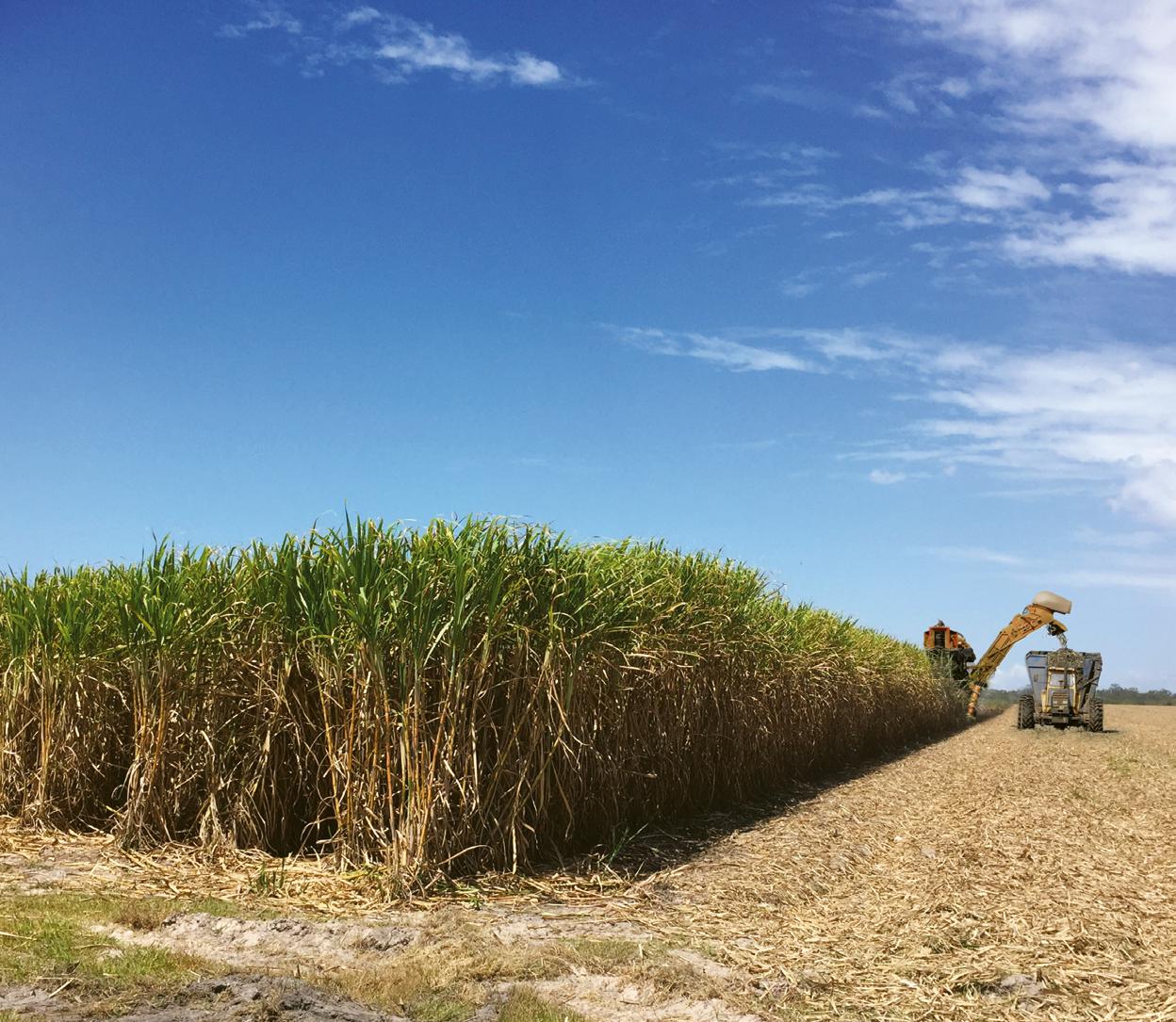





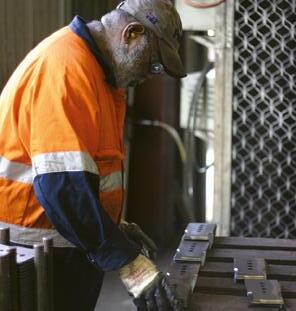
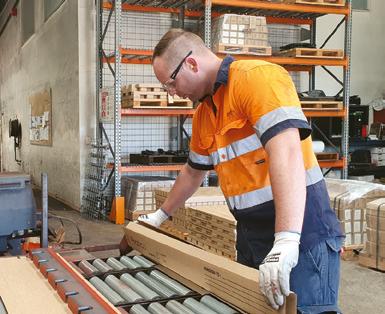
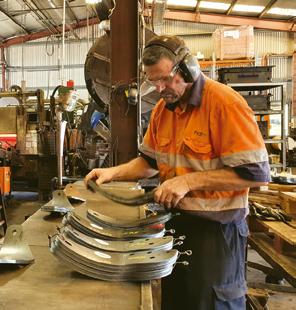
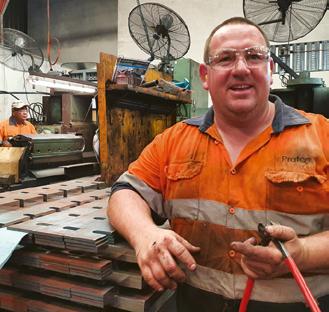



















THE OFFICIAL MAGAZINE OF AUSTRALIA'S SUGARCANE INDUSTRY 2 ®
Editor: Robyn Devine
Design:
Justin Fulton
Articles appearing in Australian Canegrower do not necessarily represent the policies or views of CANEGROWERS.

Published monthly by: CANEGROWERS, GPO Box 1032, Brisbane, Queensland 4001 Australia. ABN 94 089 992 969
Telephone: 07 3864 6444
Email: editor@canegrowers.com.au
Website: www.canegrowers.com.au
Subscriptions
Yearly subscriptions for 12 issues (postage included)
Within Australia: $176 inc GST
Overseas (AUD): $265
COVER IMAGE: Liam Wallace.
Photo Credit: Lea Coghlan
Read more on page 16
04 News Briefs Industry opportunities top the agenda 05 Fuelling the future Could Queensland sugarcane fuel the future of Australian air travel? 08 Workforce Campaign Industry ramps up efforts to boost workforce ahead of harvest 10 CEO Comment Agriculture cannot be taken for granted 12 Prioritising productivity Growers embrace new program with positive results 14 From the Chair Electricity and water prices a growing challenge for the industry 16 Future focused New to cane: Young grower achieving impressive results 24 Grower-driven harvest innovation Reversing a haulout tractor straight as an arrow in the interrow 32 Regional round-up 40 Policy updates 43 Legal updates 46 Classifieds 47 Rainfall report
INDUSTRY OPPORTUNITIES TOP THE AGENDA AT PREMIER DINNER
CANEGROWERS CEO Dan Galligan had the ear of Queensland Premier Annastacia Palaszczuk MP during a recent dinner at Parliament House to discuss the challenges and opportunities facing Queensland agriculture.
Among the topics discussed were emerging opportunities for Queensland’s sugar industry, including the development of a sustainable aviation fuel industry with sugarcane as a feedstock.
CANEGROWERS board member Mark Mammino also attended the dinner alongside his fellow QFF board directors and other industry executives.

Talking up Qld sugar’s sustainability credentials
Following his dinner with the Premier, CANEGROWERS
CEO Dan Galligan was again spruiking the industry's potential before an influential crowd in March, this time delivering a presentation at the International Sweetener Colloquium in California.

It was an important opportunity to showcase Australian sugar's credentials and explain to sugar traders and buyers how Smartcane BMP and Blockchain technology are combining to
make Australia a future power-house of sustainable sugar exports.
There were also a range of meetings discussing global sustainability frameworks and opportunities for market recognition.
CANEGROWERS' overall goal at these events is to promote our industry and product, and secure greater access to the lucrative US market.
MARKETING INFORMATION SERVICES UPDATE
CANEGROWERS Marketing Information Services provide neutral commentary on sugar market trends, pricing options and cost of production tools through Business Essentials workshops, monthly videos, and weekly market notes - all exclusively for members. CANEGROWERS members can use their membership number to access these resources on the members resources section of the CANEGROWERS website.
THE OFFICIAL MAGAZINE OF AUSTRALIA'S SUGARCANE INDUSTRY 4
Photo of dinner with Qld Premier
FUELLING THE FUTURE OF AUSSIE AIR TRAVEL
Queensland is one step closer to becoming Australia’s sustainable aviation fuel (SAF) hub and the sugarcane industry is perfectly placed to provide the feedstock that powers the nation’s jets.

Ampol Australia, Japanese energy giant ENEOS and the Queensland Government will complete a feasibility study for an advanced biofuels manufacturing plant in Brisbane, just an hour from the cane fields of Rocky Point.
Under a memorandum of understanding signed with the Palaszczuk Government on 23 March, the companies will assess the feasibility of delivering the project at Ampol’s Lytton refinery site, with the capacity to generate up to 500 million litres of SAF and renewable diesel a year.
It’s an exciting project that has the capacity to put Queensland at the forefront of a clean jet fuel market in Australia.
Initial work on the project will include looking at potential feedstock sources and how existing refinery infrastructure can be leveraged for use in domestic and export markets.
CANEGROWERS CEO Dan Galligan said the cane industry was ready and willing to tap into the potential market.
"The sugar industry is perfectly placed to provide
the feedstock that powers the nation's jets," he said.
“The sugarcane plant is one of the best natural sources for transforming into renewable energy and biofuels for heavy transport and aviation and its readily available in Queensland.” Sustainable fuel is one of the strongest tools available to airlines to reduce emissions, but it is not currently being produced in Australia at commercial scale.
SAF can be used in existing aircraft engines to cut carbon emissions by up to 80%.
5 APRIL 2023 – VOLUME 45/NUMBER 4 05
TERMINALS ISSUE TAKES CENTRE STAGE
Workforce shortages, season length, mill performance, sustainability, trade, and diversification were just some of the topics tackled by grower-leaders at the CANEGROWERS Policy Council meeting in Brisbane last month, but it was the current controversy over the operation of Queensland's bulk sugar terminals that took centre stage on Day 2.
Representatives from both Sugar Terminals Limited (STL) and Queensland Sugar Limited (QSL) fronted the council separately, to put forward their cases for and against STL's recent decision to in-source terminals operations from 2026, ending a long and successful partnership with QSL. Following presentations from both organisations, council members had an opportunity to ask questions, leading to some frank, and at times tense, exchanges.
The council later called on STL and QSL to put aside their differences and sit down together to work out a solution that is in the best interests of the industry.

CANEGROWERS Chairman Owen Menkens said growers are concerned STL's decision poses unnecessary risks to Australia’s international reputation as a reliable supplier of high quality, sustainably produced sugar.
“These terminals are a huge asset to the industry,” Mr Menkens said. “They give us a significant competitive advantage in the world market and their efficient, effective and safe operation as a service to the industry is paramount.
“Growers were the major investors in these facilities, so, we’re not about to sit quietly back and see that legacy risked in any way because these organisations are unable to agree what’s actually in the best interests of the industry,” Mr Menkens said.
The grower-led council said growers want to be assured that:
• Terminals will be operated without increased costs while ensuring efficiency and reliability
• There is a forward operating strategy and business plan in place for the terminals
• Terminal operations will always prioritise sugar access
• Pricing and access arrangements will continue to be on an equitable basis for all customers.
“The bottom line is these terminals have operated very well under QSL,” Mr Menkens said.
“And the fact that QSL is an industry-owned, not for profit organisation has given growers confidence that these assets are being managed in the best interests of the industry.
“It is now up to STL to demonstrate to growers that they can do a similar or better job, possibly at lower cost. But we have yet to be convinced of that.
“If there is a better operating model then surely STL and QSL as two organisations that should be thinking in the best interests of the industry should resolve the situation in a professional manner.
“CANEGROWERS will continue to fight to ensure this issue resolved in an acceptable way as soon as possible.”
THE OFFICIAL MAGAZINE OF AUSTRALIA'S SUGARCANE INDUSTRY 6
"We’re not about to sit quietly back and see that legacy put at risk."
You
SAVE THE DATE!
Wednesday 26 April, 8:30am – 9:30am
Duke of Edinburgh Hotel, WALKERSTON
Thursday 27 April, 8:30am – 9:30am
Prince of Wales Hotel, PROSERPINE
Friday 28 April, 8:00am – 9:00am
Ayr Travellers Motel, AYR
Tuesday 9 May, 8:30am – 9:30am
Tropixx Motel, INGHAM
Wednesday 10 May, 8:00am – 9:00am
Innisfail Bowls Club, INNISFAIL
Thursday 11 May, 8:30am – 9:30am
Mossman Bowls Club, MOSSMAN
Please join us for an informative workshop to learn more on using UPL Biostimulants & Amitron herbicide to help you reach your sugarcane yield potential.
Breakfast provided at conclusion of presentation
BREAKFASTS
GUEST SPEAKERS:
Neil Innes – UPL BioSolutions Manager
Mark Ellwood – UPL QLD Coastal Territory Manager
TOPICS:
• VITALROOT® use in plant cane
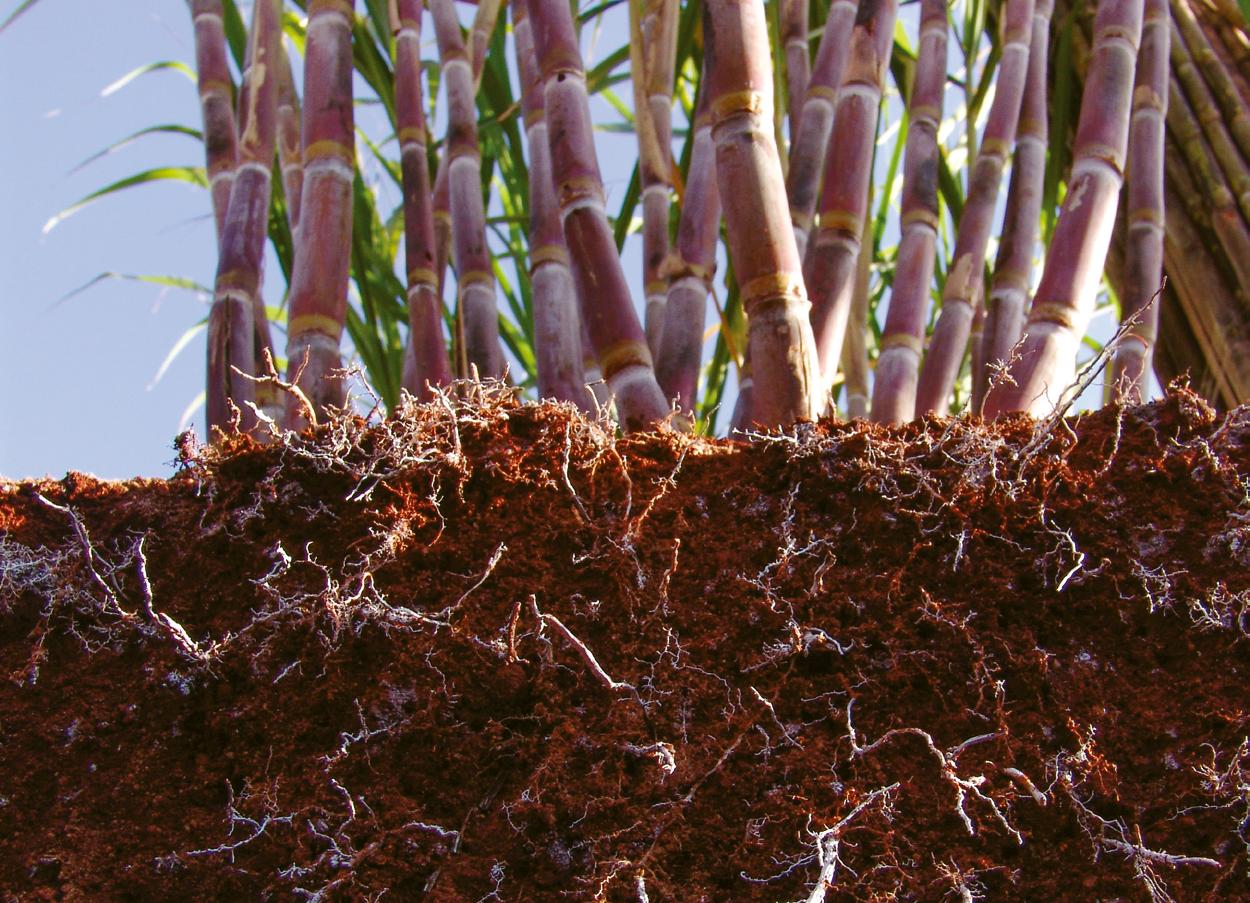
• BIOZYME® use in ratoon cane
• AMITRON® herbicide applications

Please RSVP no later than a week prior to the event
RSVP: Mark Ellwood 0448 077 945
mark.ellwood@upl-ltd.com

VITALROOT ®
in
Cane trial – Plant cane, Alloway QLD, 2021 Treatment Product rate / Ha Average cane sticks / plot @ 15 Nov 22 Mean cane yield (T/Ha) @ harvest Extra return^ ($/Ha) Untreated – 30.90 136.5 VITALROOT (infurrow) 2 L/Ha 36.10 151.6 $427.76 VITALROOT (infurrow) + BIOZYME (foliar) 2 L/Ha 0.5 L/Ha 36.26 154.7 $854.22 • increased tillering • faster emergence • more shoots & roots Trials performed by Eurofins Agroscience Services Variety: SRA11 | Planted: 6 Sept 2021 @ 9T/Ha, billet planting on 1.5m rows Harvested: 15 Nov 2022 | VITALROOT applied in-furrow with propiconazole fungicide. BIOZYME applied by foliar application 4 weeks post-emergence ^ Calculated using cane payment formula sugar price x 0.009 x (CCS – 4) + 0.6. VITALROOT RRP $15/L & BIOZYME RRP $26/L. 2 L/Ha VITALROOT @ planting +11% Yield
get more roots
sugarcane with VITALROOT
SUGARCANE INFORMATION
BOOTS ON THE GROUND
CANEGROWERS districts are proactively employing a variety of initiatives to attract workers ahead of the upcoming harvest and into the future.
As the start of the 2023 crush creeps closer, industry leaders have gone into overdrive in the quest to ensure roles for seasonal workers are filled.
Last month, both matureage jobseekers and local students came through the doors of CANEGROWERS Innisfail for the Careers in Sugar Expo.
The Expo, a one-stop-shop for those interested in a career in the industry, was led by a team from MSF Sugar, in partnership with CANEGROWERS and supported by industry bodies and training organisations.
Production Manager of South Johnstone Mill
Ian Davis, said there was a focus not only on securing seasonal workers, but delivering work experience and apprenticeship opportunituies to futureproof the workforce.
“The sugar industry is struggling to recruit and keep people,” he said.
“One of the key areas of opportunity is school students.”
“By having a day set aside, the industry is able to sell its opportunities to both school leavers and jobseekers.”
Students from three schools toured the Australian Sugar Industry Museum, guided by museum chairman and CANEGROWERS Innisfail Deputy Chair, Sam Spina Innisfail’s grower services manager Debra Telford was among leaders to address both the students and mature-age jobseekers.
“A careers day opens the door for locals to come and have a look,” Ian said.
“There was a lot of interest both from the schools and jobseekers. The feedback from all was positive and the intention is to make this an ongoing annual event.”
The event’s success was impressive with 18 students applying for work experience at South Johnstone Mill, most of which will be placed in production or engineering positions, with apprentice intakes begining in August.
13 mature-age jobseekers applied to work in seasonal roles in the cane supply area at the mill, while eight handed in applications for work in production and 10 expressions of interest for work on farms, including in harvesting teams.
In the Mackay district, new harvest workers are again receiving the opportunity to learn before they earn.
A grower-led RTO-backed Haulout Driver training course is being advertised to attract people from out
of town, new to the cane industry.
20 participants will be selected to take part in two four-day courses in May, run by highly experienced grower-trainers.
CANEGROWERS Mackay
Chairman Kevin Borg said
MEET ANGELA
Angela, pictured above, never saw herself becoming a haul-out truck driver, but after a leap of faith she has become a valued team member for one of Mackay district’s sugar cane harvesting contractors.

Inspired by a trip to Cape York, Angela registered her interest in working in the cane industry and made the move to join a rural harvesting crew. The harvesting contractor business provided accommodation for her (and her best mate and travelling companion Dave the dog), since accommodation was hard to secure.
At first, the idea of living in a small town was a bit nervewracking but it’s given Angela (and Dave) the opportunity to explore the local beaches, fishing and crabbing spots and creeks.
Image and words provided by DAF.
THE OFFICIAL MAGAZINE OF AUSTRALIA'S SUGARCANE INDUSTRY 8
the program, which has been tried and tested over more than a decade to build capability and safety standards, was recently expanded.
“While you can drive the haulout tractors on a C class drivers’ licence” he said. “We want new drivers to be safe, competent, and confident behind the wheel, and working on farm with real machinery, gives them a great start.”
Last year, the number of courses was extended to two through a collaboration with Queensland Agricultural Workforce Network (QAWN), which bolstered the original course funded by the Queensland Government


through its Skilling Queenslanders for Work initiative.
That government funding has now been secured for two courses annually until 2026.
48-year-old Leigh Mason was among last year’s intake. New to the district and with no knowledge of the cane industry, he was semiretired and looking for seasonal work.
"The course is well structured and covers everything you need for this job without being too heavy on paperwork and offers ample driving time with the instructors," Mr Mason said.
Older people who had worked across other agricultural sectors before taking up retirement or semi-retirement in a warmer climate were typical of last year’s participants. A second identified stream included women wanting to supplement family income.
CANEGROWERS' Brisbane office is also running a workforce campaign, with lifestyle opportunities in
some of Queensland's most spectacular locations being promoted across Australia and New Zealand to market the prospects of working in cane growing districts. Social media posts are also calling for growers and contractors to register their job ads in the “Work Wanted” section of the CANEGROWERS website.
Independently proven to achieve up to 98% faster strike and 52% greater shoot length, PlantStarter21 also reduces nitrogen leaching by up to 24% while supplying enough nutrients for up to 12 weeks of vigorous growth. The unique mix of nitrogen, phosphorous, zinc as well as bio-stimulants from two different seaweed extracts help increase root mass and support ultimate nutrient take up, ensuring maximum benefit to your crop.
LiquaForce – more than NPKS in a bag; committed to sustainable coastal farming.
9 APRIL 2023 – VOLUME 45/NUMBER 4 LIQUAFORCE – THE FUTURE IN FERTILISING! VISIT LIQUAFORCE.COM.AU FOR MORE INFORMATION.
REACH OUT TO YOUR LOCAL LIQUAFORCE REP: MACKAY REGION: DON MCNICHOL, 0429 540 066 CAMERON LIDDLE, 0427 765 711 BURDEKIN REGION: ROBERT WOODS, 0429 658 318 INGHAM REGION: GIANO CELOTTO, 0428 187 633 CAMERON LIDDLE, 0427 765 711 TULLY REGION: MAURICE SHEPHERD, 0457 924 762 FNQ REGION: JORDAN VILLARUZ, 0404 787 144
21 GET A HEAD START ON 2023 WITH LIKE US ON FACEBOOK
GIVE
YOUR
CROP A HEAD START, AND SAVE TIME AND MONEY, WITH PLANTSTARTER21 FROM LIQUAFORCE.
PLANTSTARTER
OUR MOST PRECIOUS RESOURCE MIGHT BE UNDER OUR BOOTS
BY DAN GALLIGAN, CEO, CANEGROWERS

Balanced against this is the positivity we see in the sugar market and the prospect of our industry becoming a major contributor to the emerging bioeconomy.
An example of this is the State Government's push to make Queensland a national sustainable aviation fuel hub, a new industry for which sugarcane is perfectly placed to provide the feedstock.
This risk exhibits itself regularly when we see the loss of quality agricultural land, resources and assets for the perceived benefit of other industries, whether that be solar, wind farms, mining and gas field development, or residential and industry development driven by urbanisation.
Soil, good soil is the heartbeat of all agriculture and food production. Making soil takes centuries. So, if we lose our agricultural soils we will not get them back.
The reality for policy-makers in Queensland is that to deliver on the potential for the bioenergy industry we will need feedstock and that will come from agriculture.
Has there been enough effort going into determining how the energy and agriculture industries will intersect?
In the end, sugarcane is an energy industry – we just happen to package that energy mostly into sugar crystals.
Our industry and therefore our regional communities can legitimately be at the centre of these growth sectors of the economy while also maintaining our existing highly successful place in the world sugar market.
But this will only happen with planning and collaboration. While much can be and will be done by us in industry, there is also a major responsibility on government to show policy and strategic leadership in this regard.
We are at risk in Queensland of repeating past mistakes and watching from the sidelines while government policy is formed around some emerging sectors at the expense of what some see as the more traditional mainstays.
But while it would take you no time at all to find the recently released $62 billion Queensland Government energy and jobs plan, or the Queensland Resources Development plan, finding the agricultural development plan, or determining the Queensland Government's vision for agriculture in this state is a lot more difficult.
Further, finding a clear articulation as to how the policies that will join the dots between profitable and vibrant farming communities and an emerging energy and innovative food manufacturing sector is impossible. But it has to be done.
Queensland will not have a new bioeconomy unless we first ensure the agricultural heartbeat of that industry is secured, not as an afterthought but as a priority. Agriculture cannot be taken for granted if we are to see the potential that is so often promised.
THE OFFICIAL MAGAZINE OF AUSTRALIA'S SUGARCANE INDUSTRY 10
"Making soil takes centuries. So, if we lose our agricultural soils we will not get them back."
Much of the industry discussion at the moment is around constraints driven by increasing production costs, such as fertiliser, water, energy and rates.

CANEGROWERS INSURANCE MORE THAN JUST FARMS CANEGROWERS Insurance is a Corporate Authorised Representative (CAR No 429264) for Community Broker Network ABN 60 96 916 184 AFSL 233750 www.canegrowers.com.au/page/insurance Protect your home, business and family with our range of insurance options BUSINESS PACKS | PUBLIC LIABILITY | HOME & CONTENTS | FARM, PRIVATE & COMMERCIAL MOTOR LANDLORDS | BOAT | CARAVAN | CYBER RISK | PROFESSIONAL INDEMNITY | MANAGEMENT LIABILITY EARTH MOVING EQUIPMENT | MOBILE PANT & EQUIPMENT | CONTRACT WORKS CORPORATE TRAVEL | TRADIES PUBLIC LIABILITY & TOOLS For more information contact your local CANEGROWERS Office
PRIORITISING PRODUCTIVITY
By Renee Cluff
Traditionally, Great Barrier Reef water quality projects have been focused on nitrogen applications. Growers are now embracing a new program which has turned that model on its head.
For almost 15 years, Innisfail District sugarcane grower Alan Colgrave has been involved in water quality projects that concentrated on efforts to reduce fertiliser inputs and modify how nitrogen is applied and filtered. With considerable gains made in decreasing Dissolved Inorganic Nitrogen (DIN) runoff in the region, there is now a recognition that further nitrogen reduction is limited or minimal.
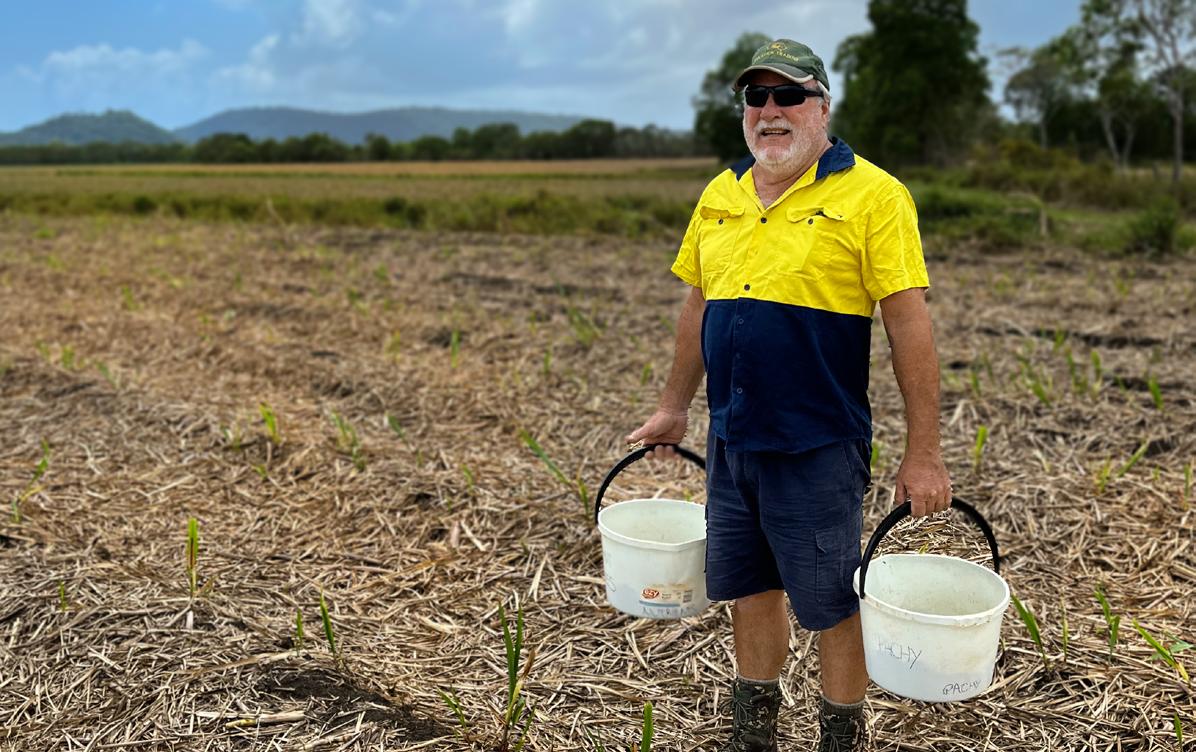
The latest water quality project, which straddles both the Johnstone and Tully catchments, is instead focused on overall plant health. Cassowary Coast Reef Smart Farming, funded by the partnership between the Australian Government’s Reef Trust and the Great Barrier Reef Foundation, is aimed at increasing nutrient uptake, thereby reducing the possibility of unused nitrogen entering waterways. Alan is delighted to be involved.
“As a grower we have been somewhat under pressure,” he explained. “Everything was about limiting our nitrogen inputs on farm. Every message we got from government was always about stifling the amount of nitrogen a grower could use on his crop. Over time, that took a lot of onus off overall soil health. We lost focus on the basics of how to grow a good crop, that being a balanced nutrition program rather than being focused on one element.
“For a long time, we have not thought about our soil as a dynamic medium to grow a crop in, it’s always been about nitrogen and therefore our productivity has been reducing. Once you go back to growing a good and healthy crop with the right nutrient inputs, you’ll be utilising those nutrients rather than them potentially moving offsite.
CANEGROWERS Innisfail is coordinating the program, which includes both the sugarcane and banana industries on the Cassowary Coast.
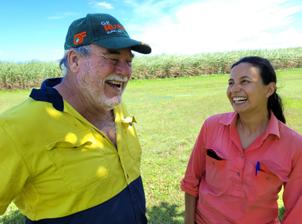
It’s a region identified by the Reef 2050 Water Quality Improvement Plan as a high priority for the reduction of end-ofcatchment anthropogenic loads of DIN.
Project leader Deb Telford said improving Nitrogen Use Efficiency (NUE) without compromising farm productivity is the project’s main goal.
“We are intent on improving productivity and profitability by refining nutrient management and farm practices to increase plant uptake of nitrogen,” she said.
“That will then keep nitrogen on the land and decrease the amount of DIN in our catchments.”
The work is driven by key constraints associated with DIN losses and reduced productivity as identified by the South Johnstone Local Expert Analysis group, which is a cohort of local researchers, growers, industry stakeholders and agronomists established by Sugar Research Australia.
Targeted extension support is providing risk profiles for root rotting disease
Pachymetra, identifying nutritional deficiencies in the soil of older ratoons and developing plans for transitions to new cane varieties.
In the banana industry, tailored, holistic nutrient
Alan Colgrave and project extension officer Maria Solis
“Common sense has prevailed.”
management plans are being developed for 30 growers through a partnership with the Australian Banana Growers Council (ABGC).
The program is not a onesize-fits-all approach, which again differs from previous water quality projects.
Deb said enduring practice change will be achieved through sustainable, tailored, co-designed management strategies that are supported by skilled extension staff and owned by each enterprise.
“This is an extension project tailored to meet the needs of each participating enterprise,” she said.
“Past water quality initiatives have relied on a prescriptive course of action, often
overlooking key differences between farms and the people that manage them.
“This project is working very closely with growers to evaluate their physical, economic and socio-cultural drivers and tailor a plan that works for them while delivering the best possible environmental outcomes.”
Grower Alan Colgrave said designing plans to suit individual operations will likely achieve higher rates of adoption.
“All growers are individuals and we have independent thoughts and we seek to make our own decisions,” he said.
“When we are treated as one entity - one mould fits all - we all look at it as being foreign
to our own ways of doing things. Our operations differ, from soil types, to labour, to the machinery we use. A personalised approach is always going to lead to greater adoption when it comes to new ways of doing things.”
More than 80 cane growers are taking part in the project, and the water quality objectives include an overall
reduction of more than 60-tonnes of DIN. Sugar Research Australia, CANEGROWERS Tully, behavioural science organisation Evidn and University of Southern Queensland Professor Bernard Schroeder are also involved in the program, which is scheduled for completion in June 2024.
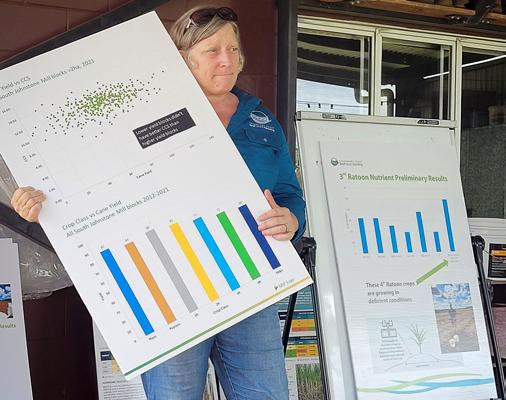
The missing ingredient for plant health and growth.
High Potency, Patented Silicon* Fertiliser
But not all Silicon Nutrients are created equal!
The only way to measure the efficacy of a silicon nutrient is through the amount of soluble, or "plant available silicon” it contains. MaxSilTM leads the competition with over 20 times the amount of plant available silicon, making it the highest potency silicon product available in the market today. You use less and pay less per hectare.
MaxSilTM’s unique patented formula helps your crops receive the nutrients they need for optimal growth, resulting in stronger, more resilient plants with better resistance to environmental stress and disease.
With over 10 years of R&D dedicated to sugar cane, banana, and horticultural, MaxSilTM is the solution for healthier crops that boosts yield. Extensive trials in Far North Queensland confirm the remarkable efficacy of MaxSilTM. Our high purity silicon-based plant nutrient has been scientifically formulated to deliver optimal results. Maximize your crop potential with MaxSilTM - the ultimate, high-potency plant nutrient.
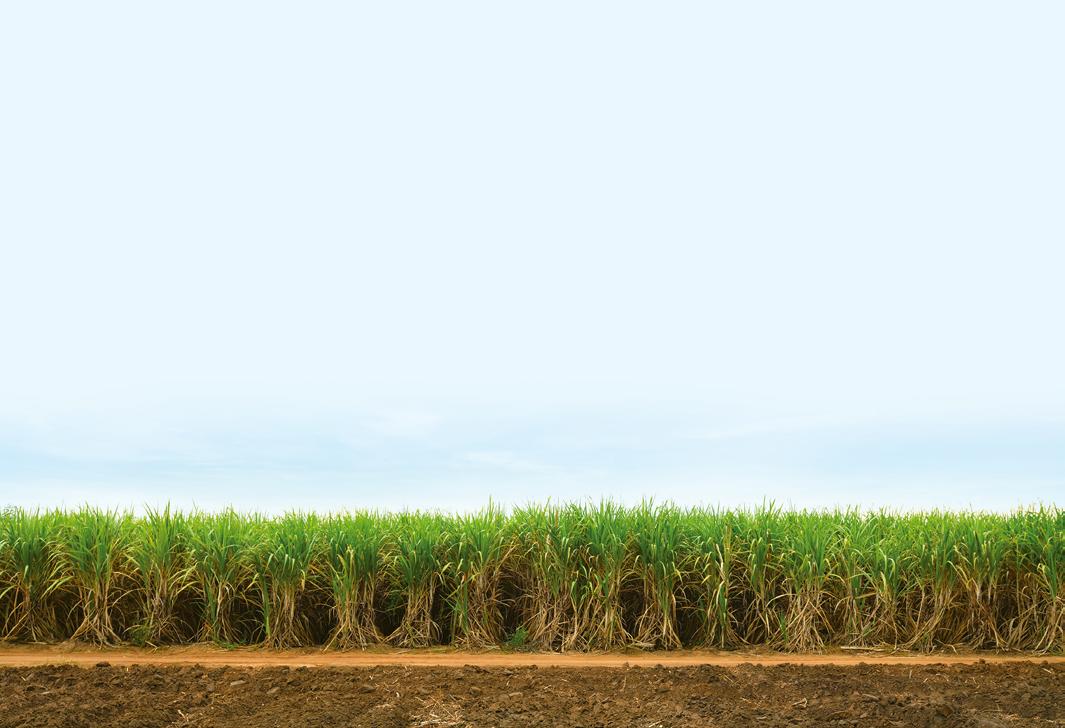
13 APRIL 2023 – VOLUME 45/NUMBER 4
“Farming is not a recipe, and every enterprise and situation is unique."
Experience the difference for yourself! Order by calling us on 07 3351 6956, or email us at, admin@maxsil.com.au Whether you’re a returning or new customer, we’d love to hear from you! maxsil.com.au
*According to Australian Health & Safety regulations, amorphous silica (MaxSilTM) poses no threat to human health. MaxSilTM has been officially approved for use as a powder as-well as a pellet.
Debra Telford addresses growers at a shed meeting
FROM THE CHAIR
By Owen Menkens, Chairman, CANEGROWERS
Mill performance, season length, workforce shortages, diversification, and government policy were just a few of the issues tackled by the CANEGROWERS Policy Council when grower-leaders gathered in Brisbane for their first meeting of the year last month.
Each of CANEGROWERS’ three policy committees presented, and the council approved policy decisions on market-based instruments, diversification and workforce issues.
Representatives from Sugar Terminals Ltd and Queensland Sugar Ltd also fronted the council to address STL’s recent decision to insource terminal operations.
CANEGROWERS is calling on both parties to come together to reach agreement that is in the best interests of the sugar industry. Hopefully that meeting will take place sooner rather than later.
One of the biggest issues that is looming for growers in the next period is electricity and water prices.
The Queensland Competition Authority (QCA) has started consultation on electricity prices and tariff determination. It looks like there could be some significant increases to current tariffs, but CANEGROWERS will be working hard to fight this, while also calling for the introduction of solar tariffs that reflect the cheaper costs of pumping during the day.
The QCA process is frustrating, but we must go through it as Ergon is a monopoly asset operator and owner.
Anytime you have a monopoly asset owner-operator the QCA process can be triggered, which brings great costs to all the players involved.
We will be pushing the State Government for more competition in the electricity sector in regional Queensland, similar to what is available in urban areas.
We will also seek the removal of the solar bonus from tariff charges, as well as making sure the Community Service Obligation is paid on the Ergon network instead of Ergon Retail.
The use of microgrids was also discussed at Policy Council. We have a unique situation in the sugar industry in that sugar mills produce electricity which is supplied into the grid and growers use electricity purchased through the grid.
The difference between what the mills receive and the growers pay is massive, with most of that difference being pocketed by government.
There is an opportunity for government to change policy to allow local grids to be established for the benefit of the industry.
There are also reviews underway into the Pioneer Valley, Mary River and Lower Burdekin water plans.
These reviews are fundamentally important in determining how the management and pricing of those systems are dealt with going forward.
CANEGROWERS, along with the Queensland Farmers’ Federation, will be closely involved in consultations as we try to ensure fair and equitable pricing for all growers.
Grower directors will be closely involved in this process to make sure we get the best outcome for the industry.
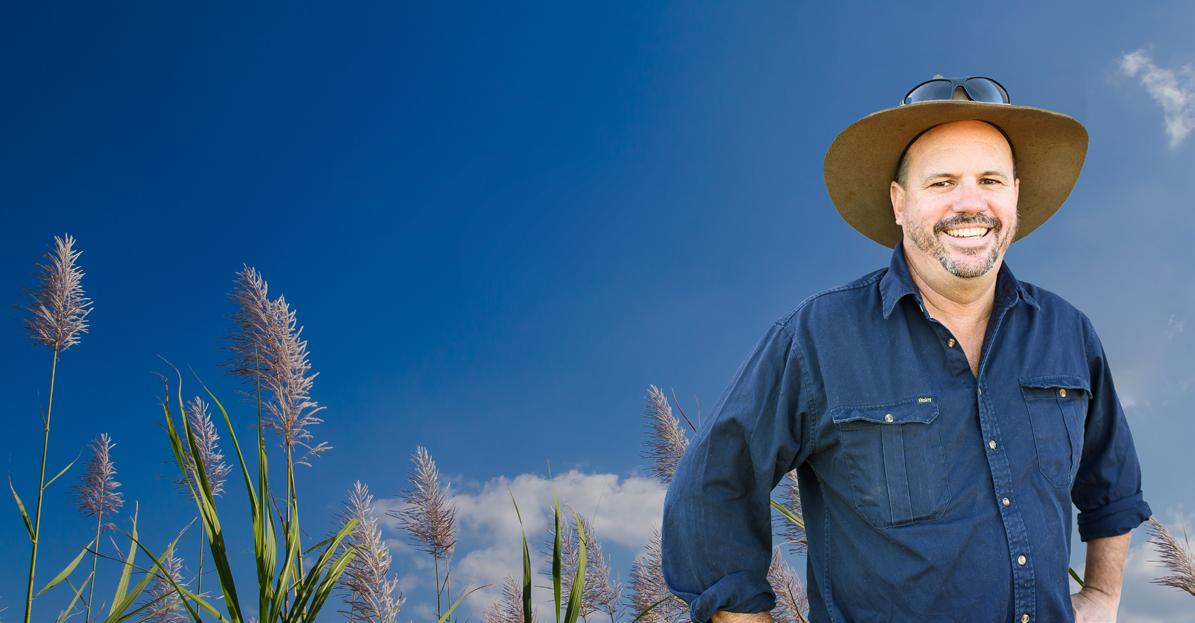

FUTURE FOCUSED
Words and photos by Renee Cluff
A philosophy of continual improvement has set young grower Liam Wallace on a course to becoming one of the Tableland’s best performing cane growers.
The 27-year-old has had a steep learning curve in growing sugarcane, but he’s fast becoming one of the industry’s rising stars.
With just four years of experience growing the crop in his role of Supervisor at CQB Services’ Biboohra Sands property, Liam is quietly achieving yields well above the local average and last season was awarded the Tableland District’s highest average CCS unit at 15.3.
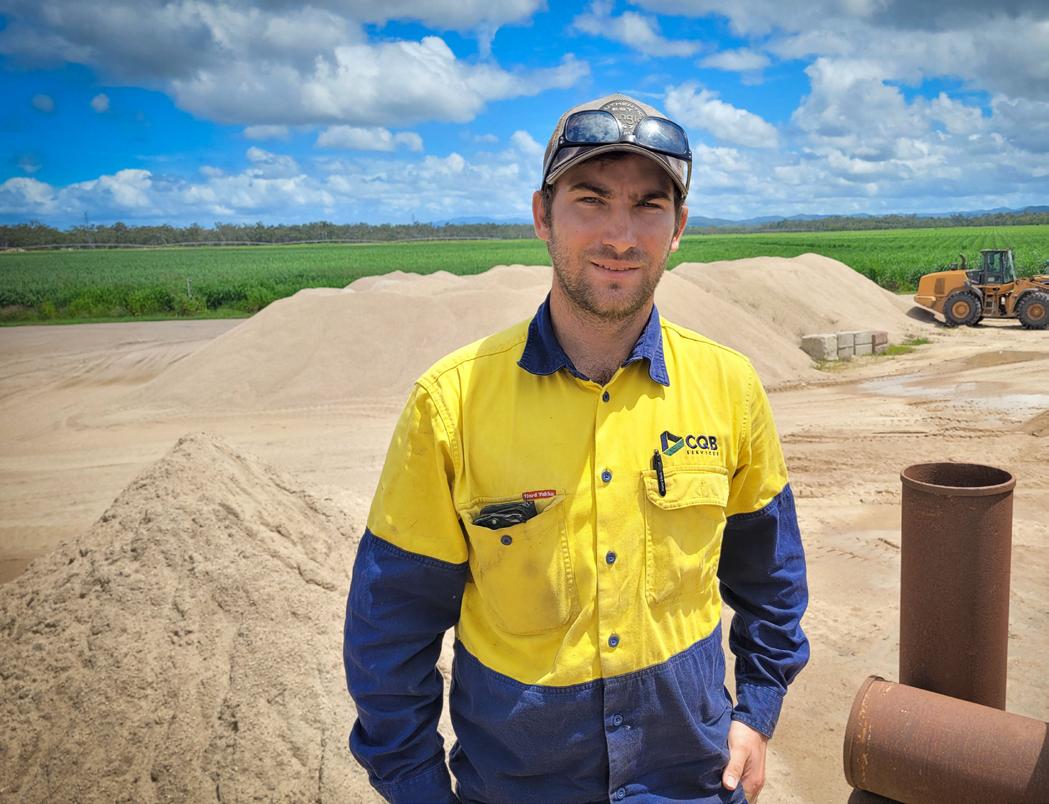
Liam is no stranger to agriculture, having grown up in Mareeba before moving to his mother’s farm in Dalby as a young adult.
He worked for cotton growers in the Darling Downs region before relocating to Western Australia to take on a role on the second largest grain farm in Australia.
It was there, while performing what most farmers would consider a routine task, that Liam suffered a significant injury.
A spray rig tyre fell onto him and broke his hip.
“I had to sit there for a while before someone found me, so I had a fair bit of time to contemplate life,” he said of the incident.
“It was one of those life-altering moments.”
THE OFFICIAL MAGAZINE OF AUSTRALIA'S SUGARCANE INDUSTRY 16
“Our philosophy is that there is always a lesson to be learnt"
The injury resulted in a reconstruction and six months of recovery, as well as a return to his hometown in Far North Queensland with a fresh sense of ambition
This renewed drive and determination was quickly put into practice through an opportunity to supervise CQB Services’ sand quarry just north of Mareeba.

The land had recently been acquired by his best mate’s families, the Stankovichs and Musumecis.
Originally, CQB’s interest in the property was focused on the land’s commercial sand resource, however this quickly progressed into a unique business model combining sugarcane growing with the quarry.
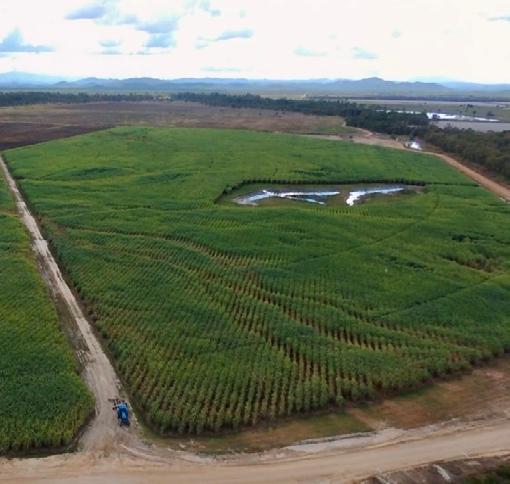
Both sides of the business benefit as sand materials are extracted and sold to create substantial water storage for the cane farm, in essence value-adding to maximise land potential.
“Basically, the end goal is to create a self-sustaining farm in terms of water,” Liam said.
“Currently the property has a 50-megalitre licence, so as we extract sand, we create water storage, allowing us to continually expand the farm. This minimises our risk and maximises our inputs to operate as efficiently as possible.”
“I was guided by the directors of the company and was lucky enough to be allowed to explore many different options and opportunities. Like we always say at CQB, ‘it’s a process of continual improvement’.”
“Obviously it hasn’t all been smooth sailing. It would have been around four months into working at CQB, and with limited experience in cane farming, I wanted to explore the grand idea of growing cotton, you know full of testosterone and all that. To start, we tried corn but that was a dismal failure to say the least, owing to army worms, pigs and a lack of water. It was a ‘getting-back-down-to-earth’ sort of moment.
“Our philosophy is that there is always a lesson to be learnt and that was a good lesson for all of us.”
Well aware of his limited experience in sugarcane growing, Liam began a deep dive into learning all he could to produce the best crop.
Initially he found it difficult to know where to look for information, however he absorbed all forms of education where and when he could, be that from local growers, MSF Sugar’s extension officers or simply online.
He discovered that the trickiest issue to overcome was the implementation of an irrigation schedule.
“We ploughed everything out and started planting back with new seed cane – just a small patch to begin with so I could figure out how to grow it before the operation expanded,” Liam said.
“We grew 40 acres at the start, including two varieties, to see what would happen. We knew our soils were highly variable –we’ve got sand, clay, sand, clay – and we had to work
out how to manage that.
"For each block we’ve probably got about four soil changes. We’ve played the average because we can’t just manage one soil type.” Liam’s research led him to fine-tune his methods over the subsequent years, including introducing CCS mapping.
“I’m now charting CCS with a refractometer,” he said. “When we get two months out (from harvest) I start mapping what the CCS is doing and then I can irrigate accordingly to
17 APRIL 2023 – VOLUME 45/NUMBER 4 Continued next page
“The trickiest issue to overcome was the implementation of an irrigation schedule”
achieve peak CCS when a certain block is cut.”
“I also created spreadsheets on water usage between clay and sands and then worked out the average for what I should put on and how best to manage the amount of water we have available at the time.
"We sourced a program to automate our main pivot, diesel pump and install moisture meters throughout that pivot.”
“Most farms might have one moisture meter per pivot, whereas we’ve got two now and we’re looking at increasing that to four. The information all comes back to my phone with a graph of where the moisture is and then I gauge it from there and irrigate as needed.
"We’ll have different segments in the paddock so I can program the system to drop 6mm here and 20mm there, or as required.
“I’m just basically collecting as much information as I
can to manage the farm better and easier.”
While Liam is aware his crop cycle is still to reach its traditional downward trajectory, he’s dreaming big – aiming for 130 tonnes per hectare with an average CCS of 15.
He’s even got his eye on 150 tonnes to the hectare but isn’t sure whether that’s achievable on his soils with a limited water supply.
To reach these goals, Liam is planning five-year ratoons with legumes planted on fallow blocks, while also exploring other methods of production.
“In time, 80% of the farm will be under cane and 20% will be under legumes and that will be the ideal rotation,” he said.
Liam is brimming with ideas and reckons he’s not the only young bloke keen to try new concepts. He’d like to establish a mentorship program in which young growers visit progressive farming operations in other cropping industries to enable them to tailor innovative methods used elsewhere to cane growing.
“I would love to see young growers provided with the opportunity to be involved in a mentorship where they can go off, say to a cotton farm or a grain farm, and see a different way of doing things,” he said.
“There are whole different systems and technologies out there and they can bring those ideas back to their farm.
“I learnt a lot from a farm I worked on owned by Jamie Grant. He’s an innovative farmer and I’ve adopted a lot of things I’ve seen him do. It’s about early adoption of technology, moisture conservation, weed management and controlled traffic and I try to use a lot of that in our system.”
“I would love to gather several younger growers who are interested and send them off. It could lead to a much-needed big step-up for the industry.”
Liam believes together with exploring other cropping systems, there is also much to be learnt from established sugarcane growers at this early stage in his career.
“I value their experience, their knowledge of economics of the crop and their efficiency in farm management,” he said. “Establishing mentorship opportunities together with embracing new technologies could draw young people back to agriculture and may be the key to future-proofing farming as a viable business for next generations.”
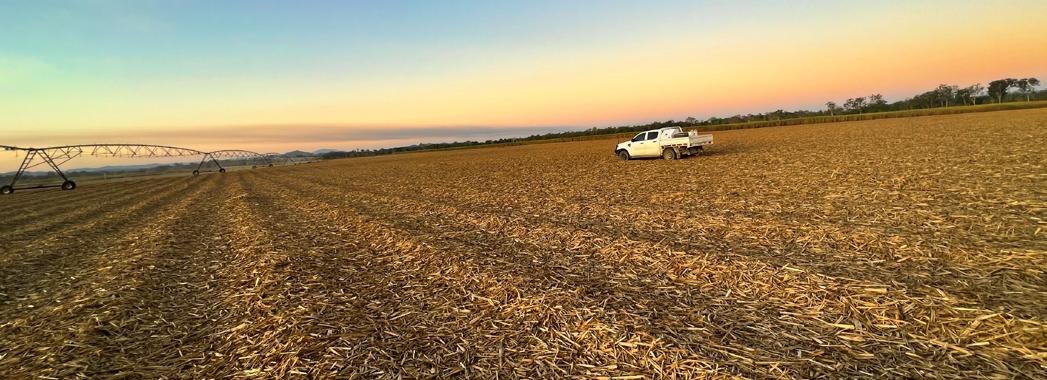
THE OFFICIAL MAGAZINE OF AUSTRALIA'S SUGARCANE INDUSTRY 18
"Liam believes together with exploring other cropping systems, there is also much to be learnt from established sugarcane growers at this early stage in his career."

19 APRIL 2023 – VOLUME 45/NUMBER 4
QSL GROWER PRICING UPDATE
Sugar Market & Currency
Your Trusted Partner
Current as of 21 March 2023.
Influence Commentary Outlook
Brazil
India
Thailand
Speculators
Currency
Estimates for the 2023/24 Season are narrowing around 580-600 million tonnes of cane after plenty of rain, however there are many concerns around logistical constraints as large grain exports are already causing delays at Brazilian ports.
By the end of February, 25.8 million tonnes of sugar had been produced from 265 million tonnes of cane. Forecasts are indicating roughly 34 million tonnes of sugar will be produced by the end of the season. The Indian government has remained completely silent around any further export quota allowances beyond the initial 6 million tonnes of sugar.
Crushing by Thai mills has begun to rapidly slow down indicating cane supply is depleting. 86 million tonnes of cane had been processed and 9.9 million tonnes of sugar produced by 6 March. Record high sugar content indicates between 11.5-12 million tonnes of sugar will be produced for the season.
After clearing houses had to deal with a cyber-attack at the end of January, we are still yet to see an up-to-date Commitment of Traders report. Reports are being back dated and should be up to date within the next two weeks.
Markets have begun to accept the idea that the US Federal Reserve may have to raise interest rates further and hold them higher for longer as data releases show inflation is remaining far stickier than anticipated. The latest US CPI figure printed a 6.0% increase year-on-year and the AUD is now trading well below 70 US cents.

Neutral
The outlook ratings above are in relation to AUD/tonne sugar prices. A bullish outlook is considered positive. A bearish outlook is considered negative.
Grower Pricing
The highest grower-managed pricing levels achieved by growers across all growing regions using QSL products to date (all gross price actual/tonne) are:
• 2022 Target Price = $700 / IFC/SMHC $705 (May23)
• 2023 Target Price = $665 / IFC $670 (Oct23)
• 2024 Target Price = $585 / IFC $600 (Jul24)
• 2025 Target Price = $540 / IFC $545 (Jul25)
Key Dates:
• 15 April: Pricing Completion Date for the 2023-Season Defaulting Target Price Contract and Grower Floor Price Contract.
• 20 April: May 2023 ICE 11 contract Pricing Completion Date for growers using the Individual Futures contract and/or Self-Managed Harvest Contract.
• 30 April: Nominations for QSL’s 2023-Season Actively Managed Pool close (28 April 2023 in the MSF and Tully Regions).
QSL GROWER-MANAGED PRICING FILLS – 2022, 2023 & 2024 SEASONS
This chart captures all pricing achieved as of 21.03.23 by growers from across all sugarcane growing regions using QSL’s Target Price Contract, Individual Futures Contract and Self-Managed Harvest products. Prices quoted at AUD/tonnes actual gross.
Disclaimer: This report contains information of a general or summary nature and is based on information available to QSL from many sources. While all care is taken in the preparation of this report, the reliability, accuracy or completeness of the information provided in the document is not guaranteed. The update on marketing and pricing activity does not constitute financial or investment advice. You should seek your own financial advice and read the QSL Pricing Pool Terms, which are contained on QSL’s website. Nothing contained in this report should be relied upon as a representation as to future matters or that a particular outcome will be achieved. Information about past performance is not an indication of future performance. The information in the report is current as at the time of publication and is subject to change, as the information is based on many assumptions and is subject to uncertainties inherent in any market. QSL does not accept any responsibility to any person for the decisions and actions taken by that person with respect to any of the information contained in this report.
THE OFFICIAL MAGAZINE OF AUSTRALIA'S SUGARCANE INDUSTRY
0 100,000 <=$470 $480 $490 $500 $510 $520 $530 $540 $550 $570 $580 $590 $560 >=$600 250,000 300,000 350,000 400,000 450,000 Tonnes 200,000 150,000 50,000 2022 Season 2023 Season 2024 Season
Your Trusted Partner
MAKE YOUR VOICE HEARD
Unhappy with STL’s plans to remove QSL as operator of the industry’s bulk sugar terminals and become a monopoly owner-operator?
Send a message to the Sugar Terminals Limited (STL) Board and support QSL’s efforts to fight STL’s plans by assigning your G-class share proxy to QSL.
Assigning your STL G-Class proxy to QSL does not reduce your STL shareholding, and you will still own your STL shares and receive any dividends paid during the proxy period.
However, your G-class voting rights will be transferred to QSL for the proxy period, adding your voice to the thousands of other grower proxy votes already assigned to QSL.
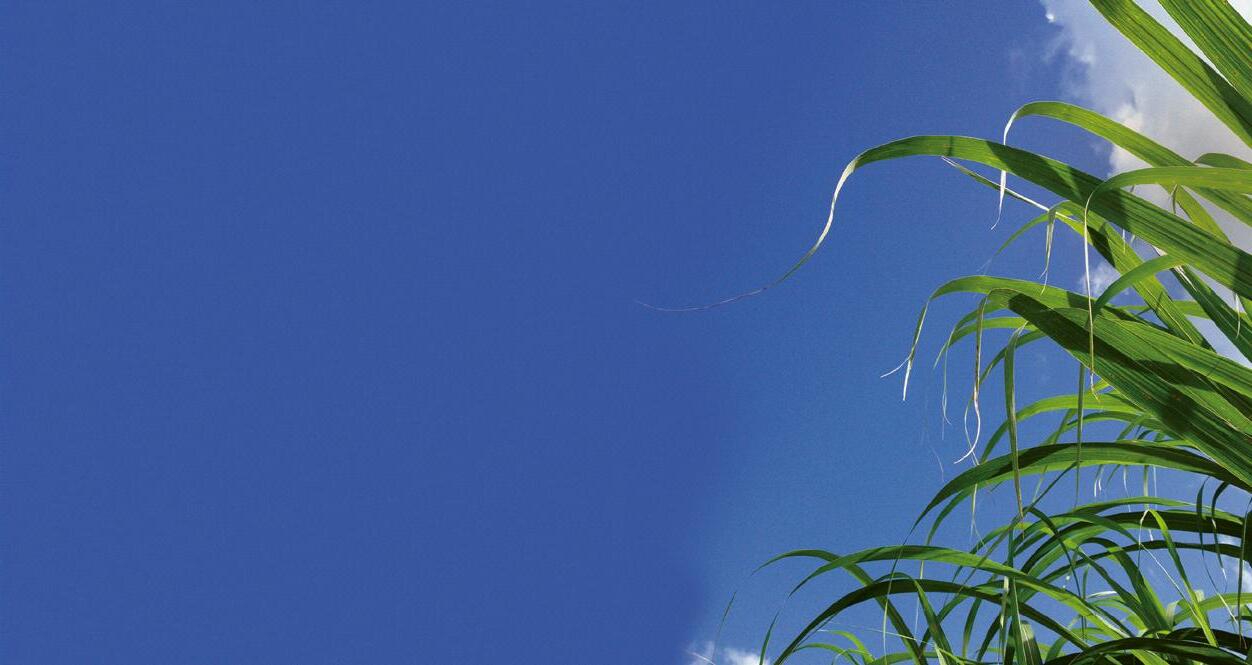
PROXY ARRANGEMENTS
Only STL G-Class shareholders can assign their proxies to QSL.
These proxies will expire on 31 December 2023, with voting rights automatically reverting back to the shareholder after this date.
Participating shareholders can nullify their proxy arrangement with QSL at any time.
Disclaimer: Please note that QSL does not provide financial advice and growers should seek their own financial advice in relation to this matter.
ATTENTION STL G-CLASS SHAREHOLDERS For more information or to assign your proxy to QSL, please contact your local QSL team or call 1800 870 756. Amanda Sheppard 0418 264 393 Daniel Messina 0429 660 238 Far North Queensland James Formosa 0437 645 342 Central Districts Karen Vloedmans 0429 804 876 Sonia Ball 0418 978 120 Kristen Paterson 0438 470 235 Hugh Leeson-Smith 0429 054 330 Burdekin Russell Campbell 0408 248 385 Southern Queensland Glenn Harris 0409 601 349 Michelle La Rosa-Aili 0408 800 937 David Matsen 0447 062 213 Herbert River Advertising Feature
IRRIGATION PRICING ARRANGEMENTS

QFF has welcomed the Queensland Government’s decision to endorse more equitable and consistent irrigation pricing arrangements for farmers through state-owned water supply schemes.

As a result, all Sunwater and Seqwater supply schemes will soon be capped at the Queensland Competition Authority’s (QCA) assessed cost reflective level, often referred to as the lower bound price.

Through the policy change, where water prices are higher than lower bound prudent and efficient costs, prices will now be reduced to reflect the efficient or actual cost, whichever is lower.
Current water prices that are below cost reflective prices, will continue to transition towards cost reflective prices as per the irrigation price path.
“QFF and its industry members have been advocating for many years on water pricing structures and the inequities this pricing can present for Queensland farmers,” said QFF CEO Jo Sheppard.
“Queensland’s agricultural sector has some of the highest input costs in the world and this decision will not only benefit farmers, but there will also be ongoing and broader economic benefits borne
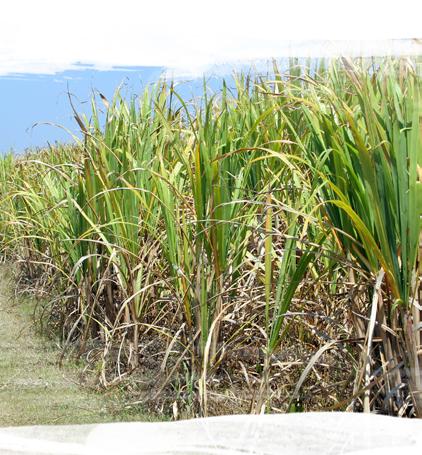
Advertisement
from the increased use of water due to affordability.”
Water is a critical input for Queensland’s agricultural sector and essential for the future success of agricultural growth in Queensland. However, this success and growth is reliant on farmers’ ability to access affordable, reliable and secure irrigation water.
THE OFFICIAL MAGAZINE OF AUSTRALIA'S SUGARCANE INDUSTRY 22
Find out more by scanning this QR Code or speak to your Regional Area Manager by calling 1800 623 946.
Authorised by the Queensland Government, Turbot St, Brisbane
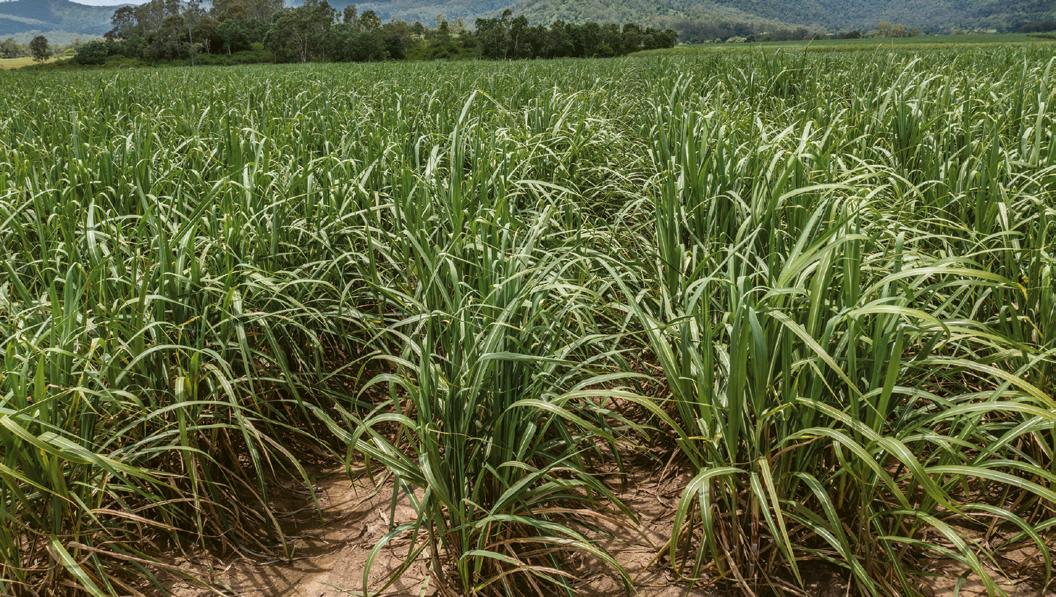



23 APRIL 2023 – VOLUME 45/NUMBER 4 Untreated Structure @ 10L/ha HELPING YOU OPTIMISE YOUR SUGAR CANE PLANT NUTRITION Introducing Structure, our highly efficient phosphorus and zinc liquid starter fertilizer ©Jenelle De Costa EASY TO RUN LOW IN SPATTER CONSISTENT PERFORMANCE VALUE FOR MONEY LASTS LONGER LESS DOWN TIME THE LATEST HARD FACING TECHNOLOGY CC WELD SOLUTIONS Want to talk Hard Facing? Call us today! We solve your welding and wear problems. Phone today: 0413 700 175 | E: mick@ccwelds.com | www.ccwelds.com Your best choice for Hard Facing Wires & Electrodes
GROWER-DRIVEN HARVEST INNOVATION
Words and photos by Kirili Lamb
Reversing a haulout tractor straight as an arrow in the interrow is a practiced art in harvesting, and not something new haulout drivers can necessarily do.
A family of growers saw a solution, but it wasn’t until after many, many phone calls to tractor and tech firms that they finally connected with a small Brisbane start-up who said “We can do that!”. The solution achieved is showing a whole slew of benefits across harvest efficiency, safety, and crop and soil health.
It’s an industry problem – when a reversing tractor goes awry it can be a safety issue, it can compact rows, cause damage to machinery, and can result in lost time and cane.
As GPS and Real Time Kinematics moved into popular use, the Grech Family could see immediately a particular application.
Across three generations, the Grech men are all growers, harvest contractors, and qualified fitters and turners. They are solutions-oriented people.
“We started with a problem,” said Michael. “Getting drivers to reverse fill and stay beside the harvester - and off the stools.”
There was a need to bring auto-steer to the reversing process, to address problems such as driver training, risks to stools and machinery, the pitfalls of working with mirrors, or fatigue from constantly looking back over the shoulder.
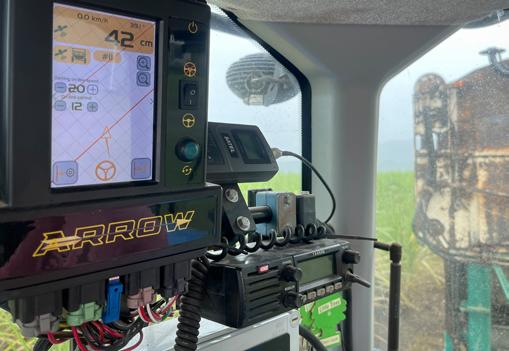
Nathan said they had seen the efficiencies inherent in reverse filling in the past, when they had been using rubber tracks on tipper bins and tractors, reducing the need for lost time on change outs in wet conditions.
“For the size of the machines, it was much easier to forward and reverse rather than turning around. We have gone from tracks to wheels since then, and we have still seen the efficiency of forward and reverse filling,” he said.
“Once you get used to it, stick it out, everyone preferred it, they could see the benefits from it,” Nathan said. “Given a choice between turning round at the ends of the rows or reversing, everybody would choose to reverse.”
Why does that efficiency gain matter?
“Mills want bigger harvesting groups, so you’ve got to pick up every second, as much time as possible. There is that area where you can pick up, not turning on the ends, where you are least productive," Chris explained.
"And that’s where the forward and reversing comes in. Initially, it was because we were on rubber tracks, but when Nathan went to the tri-axles, we still wanted to go with forward and reversing, to keep up efficiency.
“We were one of the first to go to full-time harvesting with a full track harvester, and look where it has gone. We have always tried to be leaders in the industry, from back in our days –Kevin, Michael and myself. And now Nathan has come along and brought in new changes also.”
Efficiency gains with reverse fill can be a swift as 15 seconds of elevator off-time at ends of rows, elevator engine hours being a core productivity measure.
Committed to the tech solution that they could see
THE OFFICIAL MAGAZINE OF AUSTRALIA'S SUGARCANE INDUSTRY 24
Continued page 26
“We started with a problem, getting harvest drivers to reverse fill and stay beside the harvester - and off the stools.”
On-tractor ECU and interface.
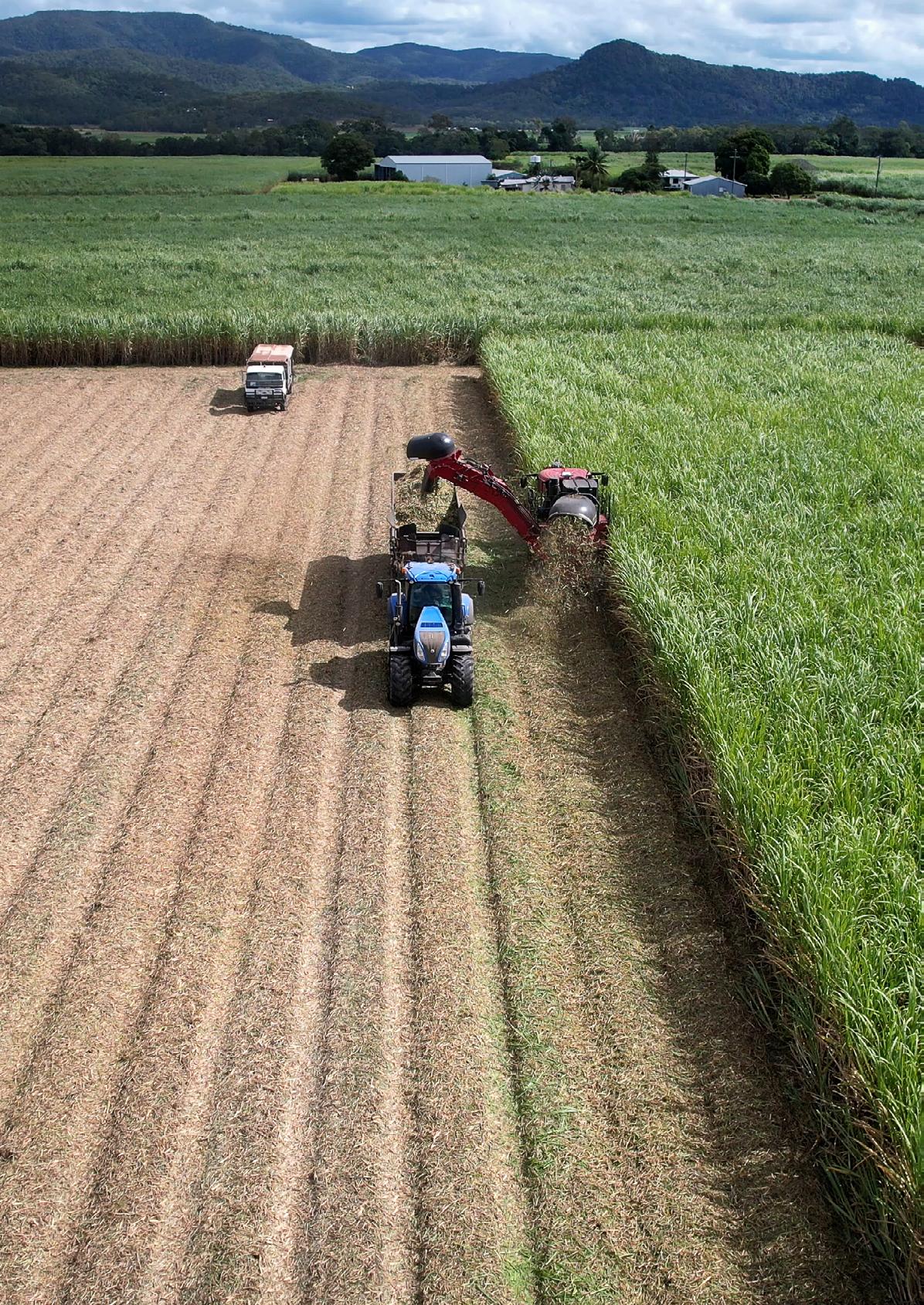 Reversing straight to a programmed positional line. Photo: Clayton Grech
Reversing straight to a programmed positional line. Photo: Clayton Grech
that would make this approach easier, Michael, who had recently retired from his work in the engineering sector, set about finding the reverse trailer autosteer technology they – and other contractorsneeded.
“I rang about 20 different tractor companies, asking what technology they had,” Michael said. “But I got told it was too hard. No-one had any ideas or solutions.
"People outside the industry don’t understand why we
want to do it. No-one seemed interested.”
Two years later and still undeterred, Michael finally connected with a small Brisbane-based tech startup – 2Infinity Control Solutions. He spoke to them at the very end of 2021, and by the start of the 2022 crush, their tractors and trailers were fitted with an innovation on an existing autosteer control system.
2Infinity owner/principal engineer Neil Rutland is a UK-born engineer with a PhD in control systems and a background in military applications for guidance, navigation and control systems. When he turned his attention to agriculture in Australia, he connected with colleague, control applications engineer Brendan Joiner, at AgJunction in Brisbane.
They were colleagues for 8 years, before Neil established 2Infinity in 2017, joined by Brendan a year later. Brendan grew up on a dairy farm, and his earliest work was in cotton, with Beeline Technologies, a pioneer in tractor auto steer.

“Farming is in my blood, but I always loved the tech stuff and then I got to use that to assist farmers to improve productivity and efficiency through automated steering,” said Brendan. The company had already developed the “no bells and whistles” Arrow autosteer, a challenge they had set themselves when they established the company, after hearing farmers complain of overcomplicated control systems full of features they never use.
The reversing trailer control (RTC) innovates on that initial autosteer.
“We were doing steering for tractors already when we were approached about steering a trailer in reverse, where you just steer the tractor and there is no steering in the trailer. That is the same simplicity as reversing a ute and trailer: it’s all in the front axles. We knew if people could do it, then we could automate it. We knew it would be a challenge, but we were confident we could do it,” said Neil.
Brendan elaborates: “So, the Arrow-RTC concept is quite simple - from the outside anyway - when travelling in forward direction ArrowRTC controls the position of the tractor, just as the standard Arrow or any other guidance system would do.
THE OFFICIAL MAGAZINE OF AUSTRALIA'S SUGARCANE INDUSTRY 26
From left, Nathan and Michael Grech, Neil Rutland, Brendan Joiner and Chris Grech.
"Paddocks are mapped with data stored and easily transferred via USB between tractors."
“When it detects reverse travel direction it then controls the position of the trailer, still only using the tractor’s front axle steering. We use dual RTK receivers on both the tractor and trailer along with inertial sensors to get full position information into the controller.
“It took us about four months of development to add the trailer control to the existing Arrow system. By industry standards, that is rapid development. That is part of what makes us different, our small size and breadth of skills allow us to be agile developers. We also use in-house developed simulation and modelling tools that reduce the amount of field testing required.”
Paddocks are mapped with data stored and easily
transferred via USB between tractors. The reverse camera extends capacity to comfortably watch the surrounds.
Brendan and Neil laugh as they show a picture of initial trialling of the system before they were ready to bring the components to Mackay for fitting. That initial field testing was done using Neil’s ride on mower (with auto steer fitted) and a modifiedto-scale ATV trailer simulating Nathan’s tractor and trailer combination.
The system was then ready to fit to tractors when they came to Mackay, within the deadline of a May harvest start.
“It worked from day dot. I couldn’t believe it when I got in the tractor,” said Nathan. “You set the A-B line and bang, straight on it.”
Operator fatigue has been a consideration. The Grechs are pleased to report great feedback from their haulout operator crew regarding the autosteer trailer reverse. Initial in-harvest trials involved two haulout drivers using the RTC, and one operating manually.
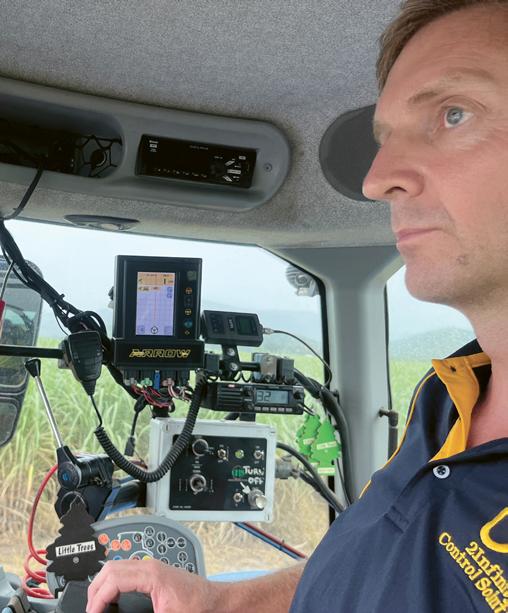
“At the end of a big day, we spoke to the two guys that had the GPS, and to the guy that had to reverse all day. And you could just see the
difference in fatigue, a big difference,” said Chris.
Nathan noted that, because a lot of their workforce now were older workers and retirees, that was a critical factor aiding staff retention.
“You don’t want the older people getting tired. They are good- they turn up every day, they are reliable,” Nathan said.
Past vision issues, such as dusty dirty windows or glare when the sun is low (or gone for the day) are now eliminated.
One unexpected outcome turned out to be that labour retention. By creating a physically more comfortable, less fatiguing work situation, last year’s crew are all keen to work with the Grech’s harvest business OnTrack Harvesting again in 2023.

27 APRIL 2023 – VOLUME 45/NUMBER 4
Brendan Joiner demonstrates Arrow RTC’s performance on the Grech farm.
Continued page 28
Trailer RTK GNSS arms and ECU sensor, which is paired to on-tractor RTK GNSS and ECU.
"Past vision issues, such as dusty dirty windows or glare when the sun is low (or gone for the day) are now eliminated."
Similarly, it has made the haulout driver training process that much quicker.
Nathan noticed that they, as harvester operators, could relax a little also.
“You are always looking out for each other; you keep an eye out. They can be staying straight 99% of the day, but it only takes that one row where they drift off, and before you know it, they can be reversing into your pump box. As a harvester operator, for me, you are always alert, always watching. You go home at night fully wrecked,” said Nathan.
“You get to know who you have got beside you, and what you have to watch for. But last year, with the RTC, it was just so much easier, so much more relaxed. It saved my neck, I had to look at the elevator half the amount of times.”
He felt the biggest result for farmers was the reduction in compaction on the rows.
“We are only running on our controlled traffic areas,” he said. They said the tendency for drivers reversing by eye, using trash blanket tracks as a guide meant that if one followed a line of error, others would follow.
Precise to two centimetres with the tractor and to within four centimetres with the RTC, the marks seen in the trash blanket at the end of the day were only in the interrow.
“The track that has been laid is a dead straight line,” Chris said.
Nathan’s son Clayton, 16, is studying drone piloting at school, and his footage shows the high-precision performance working to an A-B line. (Scan the QR code to check out the harvesters in action)
Not turning at the ends means reduced compaction at row ends also.
Having worked hard to achieve this solution, having had the vision and invested in that vision, the Grech’s can now say that they are both happy and relieved by the outcome, and are looking forward to another year’s harvesting with increased safety and efficiency.
“We’re more than happy coming out of the [2022] season knowing how they went,” Chris said.
Moreover, they can see this as technology with applications outside cane harvest where accurate or challenging reversing is essential.
“Brendan and Neil have started on this, but I reckon the system can be put onto a hell of a lot of other machinerytrucks and trailers,” Michael said. “It will have a lot of applications.”
The Grech family has been farming cane for three generations, with the fourth coming through, now in their teens. The family farm is at Munbura, just south of Mackay. Brothers Chris and Michael are working the farm, while younger brother Kevin runs a second farm nearby.
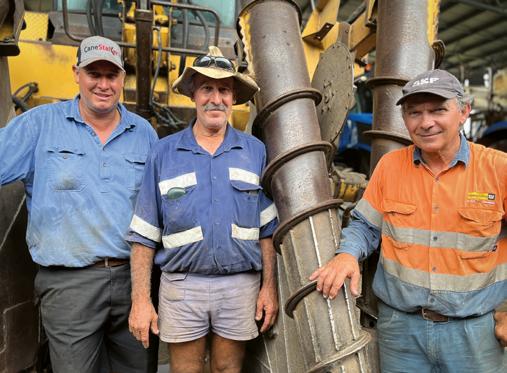
Chris’ son Nathan is engaged with both the farm and the harvest contracting business with Chris. They have 270 hectare under cane across the two farms, and fallow with twice yearly cash crops of soy or mung bean. Their harvest group cut 89,000 tonne in 2022.

THE OFFICIAL MAGAZINE OF AUSTRALIA'S SUGARCANE INDUSTRY 28
"The marks seen in the trash blanket at the end of the day were only in the interrow."
From left, Nathan, Chris and Michael Grech.
2Infinity Control Solutions team-senior Control Applications Engineer Brendan Joiner, left, with owner and Principal Engineer Neil Rutland.
Updating the Growers

It is hard to believe we are already a quarter of the way through 2023. The year has flown by as we prepare for another busy crushing season at our six bulk sugar terminals from Cairns to Bundaberg.
A very late end to the 2022 crushing season
The 2022 crushing season was a particularly challenging time for Queensland’s sugar industry, with many factors impacting the completion date. As a result, a number of STL’s bulk sugar terminals extended receival services well into January 2023. STL’s primary focus will always be on the receival, storage and shipping of raw sugar and on maintaining these assets that play such a vital role for the industry and the Queensland economy.
Ongoing investment in the Sugar Terminal Assets
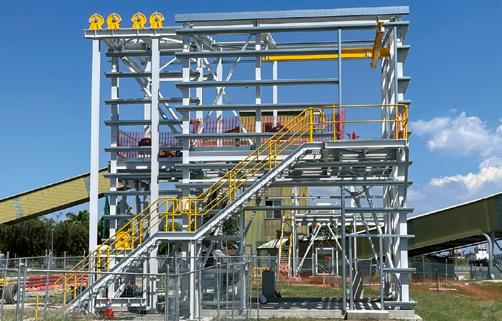
STL’s 10 year, $100 million shed roof replacement program was successfully completed in late 2022 with the completion of Shed 1 in Townsville.
STL continues to actively invest to ensure the longevity of these assets to service the Industry for decades to come. On average STL funds approximately $18M per annum into an ongoing capital investment program. This year’s program includes replacing the 12 km long Lucinda jetty conveyor belt, replacing major electrical substations at Lucinda and Townsville, modernising the shiploader control systems at five terminals, and ongoing replacement of conveyor belts, motors, gearboxes, switchboards and fire protection systems across all sites.
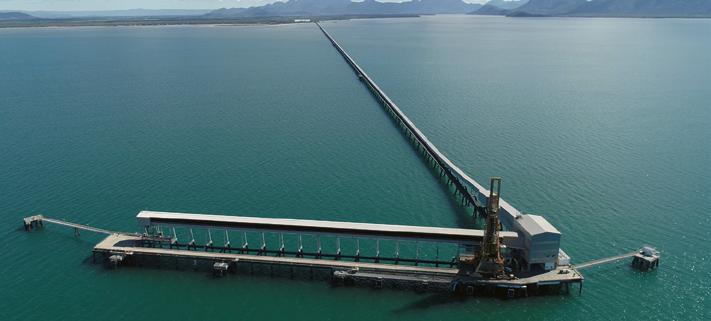
We are also continuing to actively engage with Ports North over their Masterplan to ensure the importance of the Cairns Sugar Terminal for the Sugar Industry is recognised and also with the Department of Defence around the upgrade to neighbouring HMAS Cairns facility.
New Bundaberg infrastructure on track
New common user infrastructure being built in Bundaberg is expected to be up and running in the third quarter of 2023. With a focus on using local suppliers wherever possible, Gladstone-based Loftus Contracting completed the civil works in December and in recent months, local Bundaberg company BME Australia has been busy fabricating the main structural components for the new conveyor system and loading facilities. These are already being progressively delivered to site and installed.
This project complements STL’s core sugar business in Bundaberg and is focused on attracting new bulk export commodities to the Port, such as agricultural, timber and mineral products.
Insourcing of Operations
As you would be aware, STL has recently decided to insource the terminal operations, and therefore terminate the Operating Agreement (OA) with QSL. The right of STL to insource operations was always an option available under the terms of the OA previously agreed with QSL. By insourcing operations, STL will remove unnecessary corporate overheads costs and drive greater efficiencies with the ultimate goal of reducing cost to industry without compromising the quality or reliability of our services. This decision has been made to benefit the entire Sugar Industry and will also involve STL offering employment to all current site based operational employees on the same terms and conditions of employment including continuity of service. STL is currently undertaking a very active communications program in all regions to further explain the background to this decision. If you have any specific questions please do not hesitate to call 1800 318 239 or email us on: operations@sugarterminals.com.au
Welcoming our new CFO
At the end of March, we welcomed Chris Wagner as our new Chief Financial Officer and Company Secretary. Chris is perfectly suited to take on the role, with more than 20 years of experience in transport, shipping, ports, stevedoring, supply chain management and telecommunications. He also has considerable experience with customer engagement, especially in regional parts of Queensland, which will suit the broad geographic nature of our business.
I’d like to take this opportunity to sincerely thank Peter Bolton, whom many of you may have met during the last six years, for his service to STL. We wish him well in his future endeavours. In closing, let me thank you for your ongoing interest in STL and wish you all a safe and productive crushing season in 2023.
David Quinn Chief Executive Officer
STL Grower Update | april 2023 | info@sugarterminals.com.au www.sugarterminals.com.au
Steel framing underway for the Transfer Tower #1 at the CUI Project at the Bundaberg BST.
Advertising
Planning is well underway for the Lucinda wharf conveyor belt replacement project
Feature
TRAP CROPPING AS A TOOL TO COMBAT GREYBACK CANEGRUBS IN MOSSMAN, FNQ
Nader Sallam, Simon Engdahl & Melanie Toyne; Mossman Ag. team
The greyback canegrub (Dermolepida albohirtum) is a significant pest of cane crops in central and north Queensland.
Periodic outbreaks may occur when conditions are favourable and if pesticide applications relax following a period of low infestation.
In Mossman, damage by this pest in 2022 was estimated by Mossman Ag. Services to be in the vicinity of $1.5 million in lost revenue and hidden costs (i.e. increased dirt at the mill, plough-out replant operations etc.).
While chemical application remains the key factor in canegrub management, other practices may also offer a degree of population suppression.
Another farming practice proven to work is trap cropping. Trap cropping arose from observations that egg-laying beetles are attracted to early-harvested cane strips that were significantly taller than surrounding cane.
Trap crops were also shown by Horsfield et al. (2002) to harbour more grubs/stool compared to adjacent blocks in selected areas in the Burdekin and the Herbert regions.
These observations led to the development of the ‘trap crop’ concept, which is a section of a field that was either planted or harvested earlier than the rest of the crop, and so stands out in comparison to the rest of the crop at the time of beetle flight.
The greater the height difference between the trap crop and the adjacent cane the more effective the trap is likely to be.
Forage sorghum was shown to also attract egg-laying females very effectively, and, if significantly taller than cane at the time of flight, it can attract most egg-laying females in a given area (Sallam 2008).
Cane used as a trap crop may be protected with the maximum allowed dose of insecticides to ensure effective grub control, while sorghum trap crops may be sacrificed using a herbicide if field conditions permit, and this will starve grubs of their food source.
The significant grub infestation levels experienced in Mossman in 2022 prompted Mossman Ag. to work with affected growers towards finding plausible solutions.
In addition to revising and reinforcing chemical control efforts, several trap crops have also been established on selected farms.
While sorghum has already been proven to make an excellent trap crop, we also trialed sunn hemp (Crotalaria juncea) which is a fast growing, vigorous legume.
The thought was that sunn hemp may be successful in attracting a proportion of the beetle population while also benefiting the soil through fixing Nitrogen and improving organic matter.
For the purpose of this trial, strips of sorghum were alternated with strips of sunn hemp in most cases. While in a few cases sorghum and sunn hemp were planted in separate blocks.
The majority of the crops have been planted on elevated blocks, and planting took place in late September – early October 2022.
At the time of beetles’ flight (mid-Dec- earl January), sorghum and sunn hemp crops were either the same height or marginally taller than adjacent cane, however their elevated placement on a hill gave them the advantage of appearing significantly higher.

Crops were dug up in February – March 2023 and the number of grubs/stool was counted.
The following table shows average grub numbers/ plant under sorghum, sunn hemp and adjacent cane in three trap crops in Mossman.
THE OFFICIAL MAGAZINE OF AUSTRALIA'S SUGARCANE INDUSTRY 30
Sorghum and sunn hemp
Grub numbers were highest under sorghum followed by sugarcane, while sunn hemp has generally attracted the lowest numbers in most cases. This work confirmed previous observations that sorghum crops planted in good time so that they stand out at time of beetles’ flight attract higher number of egg-laying females.
This work also shows that sunn hemp is a host for

greyback canegrubs, albeit less preferred compared to sugarcane or sorghum.
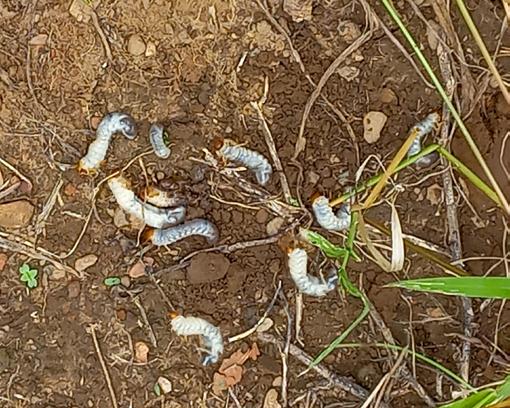
Trap crops would be most efficient if they are significantly taller than adjacent cane at the time of beetles’ flight.
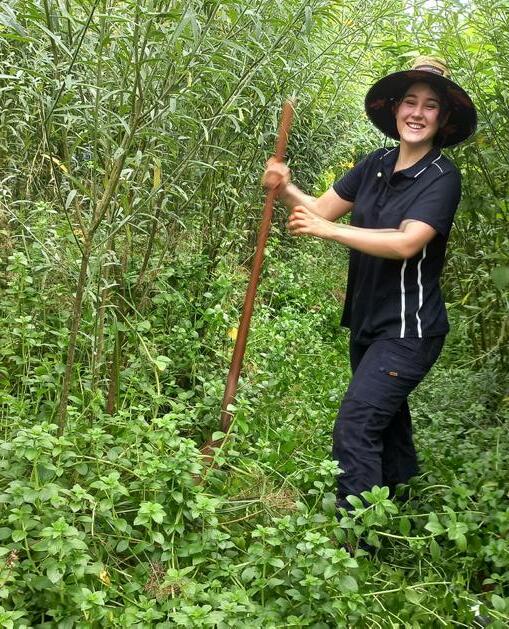
They also need to be sacrificed quickly before 3rd instar larvae complete their feeding under cane and prepare to pupate. Slashing and spraying out trap crops
while most grubs are still in their early third stage is likely to starve them off.
Third instar grubs need to feed extensively for at least 10 weeks before they can pupate, which usually happens in AugustSeptember. Sacrificing the trap crop in March, weather dependent, is likely to deprive the grubs off their essential food source and is therefore likely to suppress their numbers significantly.
Reference: Horsfield A, Logan DP & Kettle CG. 2002. Trap crops for the management of greyback canegrub in the Burdekin. ASSCT Proceedings; 213-218. Sallam N. 2008. Trap cropping in far north Queensland. BSES Bulletin 19, 5–7.
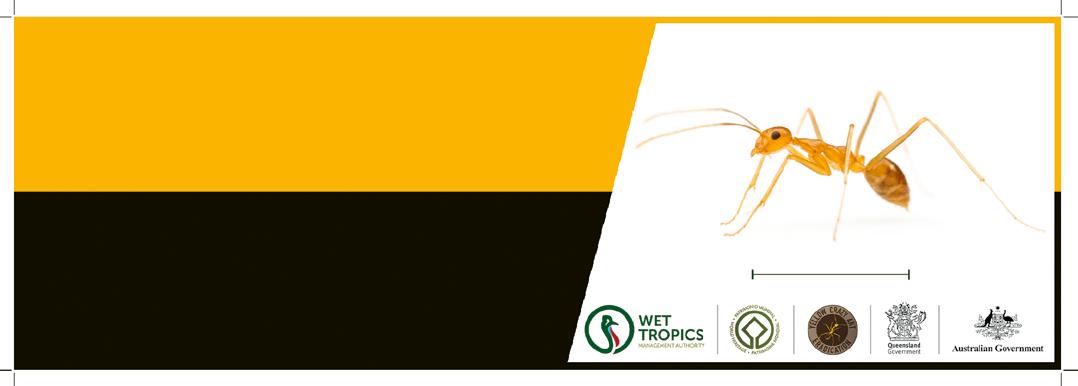
31 APRIL 2023 – VOLUME 45/NUMBER 4
Farm Sorghum Sunn Hemp Adjacent cane A 7.7 (1-20) 0.1 (0-1) 0.4 (0-1) 1.1 (1-5) B 3.5 (3-9) 0.2 (0-1) 0.6 (0-1) C 1.0 (0-3) 0.5 (0-1) 0.3 (0-1)
AVERAGE GRUBS/PLANT (min-max)
Melanie Toyne digging up sorghum plants
More grubs under sorghum
CANEGROWERS REGIONAL ROUND-UP

Supplied by CANEGROWERS district offices
At the time of writing Mossman growers are trying to finalise crop estimates for the mill. The late finish to the 2022 harvest is making that difficult, with some cane doing well but the late cut cane is still struggling to get fully established due to the continued wet conditions.
February was again a wet month with a 55 year record of 1,248.8 mm of rainfall. March has been patchier with some short heavy falls but a bit more broken up with overcast and sunny periods. The mill has a working estimate of 721,361 tonnes of cane with 436,350 tonnes on the coast, which is about 45,000 tonnes less than 2022. The reduction is due to a combination of the late finish in 2022 and the continued loss of
TABLELANDS
This last month saw a visit from the QCGO Board to the district. Owen Menkens (Chair), Mark Mammino, Joe Marano and Matt Keally had a chance to meet with growers and visited a local grower’s farm.
SRA held two information sessions in the Tableland District presenting findings on projects, i.e. irrigation, RSD, weed control. It is highly recommended that growers
cane growing land. Once grower estimates are in, it will be interesting to see how the two compare, as some growers are predicting a drop of more than 50,000 tonnes overall on 2022.
The Grower End of Season and Industry Update meeting held on 27 February was well attended with an open and frank discussion with both mill and QCGO representatives about seasonal and industry matters. Having had more rain in the days leading up to the meeting instead of a farm tour the QCGO representatives were taken on a tour of the CocoNutz value-add facility situated on the Far Northern Milling (FNM) mill site.
The Mossman Agricultural annual shed meeting held on 10 March was also well attended,

growers heard from Gavin Rodman (SRA) about a planned CCS Improvement project for Mossman growers, Emilie Fillols (SRA) spoke about the latest results with chemical trials and weed management while Nadam Sallam (MAS) spoke about grub strip trials with hemp and sorghum. A Douglas Shire Council representative discussed an upcoming ‘Opportunities Workshop’ being planned for agriculture in the Shire and NQ Drones gave a drone
demonstration showing how drones can be used to spray crops.
On the FNM maintenance front, the No. 1 top milling train roller was sent south for repair in January, the No. 6 mill was sent to NQEA for shaft repair in February, warming fires were light in the JTA boiler to dry out fire brick insulation after a final clean out of old residue from the 2022 crushing and on a lighter note, congratulations to the four FNM Apprenticeship Award winners for 2022.
attend these sessions when SRA run more in the future.
As mentioned last month Far Northern Milling (FNM) and MSF are in negotiations to reach a toll crush agreement for the total of Tableland District cane. If an agreement is reached, Tableland Mill will have a total 850,000 tonnes to crush, of which 250,000 tonnes currently is under consignment to FNM.
The crush would start mid-May and take between 27 to 28 weeks to crush. At this stage awaiting the outcome of these
negotiations. Keep an eye out for an invite to the Awards Night and clean seed sale forms.
THE OFFICIAL MAGAZINE OF AUSTRALIA'S SUGARCANE INDUSTRY 32
MOSSMAN
CAIRNS
The Region has experienced flood rain over the past weeks. The catchments are full with the inundation of the crop in some of the lower reaches. Although there has been intermittent sunshine the late cut cane is suffering from the excess rain.
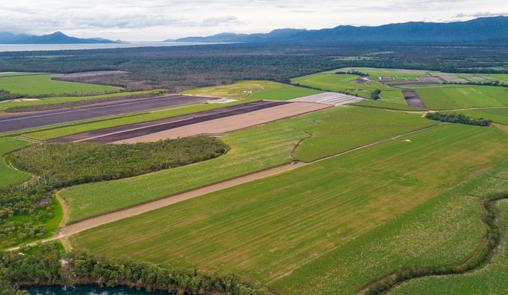
At the invitation of MSF Sugar, representatives of the
organisation along with invitees from other organisations met with MSF Senior management to undertake a strategy session for the local industry. Disappointedly the outcome wasn’t what was hoped for, but leaders will continue to work within this group to drive better outcomes for Members.
Recently CANEGROWERS
Cairns Region held a Chemical Accreditation training course for members courtesy of BMP program funding. The course was attended by eight growers. Jack Robertson from DAF also attended the training and gave a presentation on modes of action of commonly used herbicides
within the cane industry and a nozzle selection demonstration. The group also travelled to a nearby farm where Jack demonstrated the effectiveness of utilising a spray boom analysis device to assess a spray booms output.
On 2 March, CANEGROWERS
Innisfail representatives participated in MSF Sugar Ltd’s “Grow Together” initiative, which aims to identify and agree on key industry growth and sustainability strategies for MSF Mill areas. Participants at the workshop included Thai owners, Mitr Phol, MSF Staff and representatives from CANEGROWERS Innisfail, Cairns Region and Tablelands.
INNISFAIL TULLY
The wet season has continued in the Tully District with 1615 mm recorded to date, which is similar to the previous year. Early growth patterns suggest a larger than average crop again for the 2023 crushing season, with estimates currently suggesting 2.7 million tonnes.
Each organisation tabled feedback collected from their respective growers regarding the key areas of the sugar value chain. Facilitated workshop sessions focused on identifying the opportunities and risks for industry growth and sustainability and, more importantly, what actions are needed in the short, medium and long term.
CANEGROWERS Innisfail once again supported MSF to host the second, annual Careers in Sugar Expo. The day was
considered an all-round success with around 50 senior school students from three local schools participating. Students heard from industry professionals and job training representatives about career
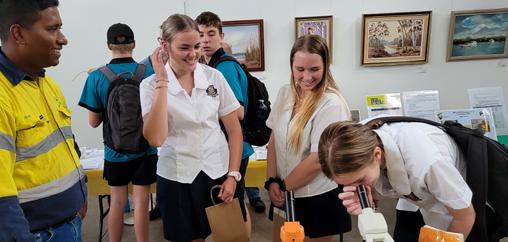
opportunities within the industry. The afternoon session welcomed potential job seekers with many registering expressions of interest for local farming and harvesting work.
Tully growers and industry representatives attended the Business Essentials course in Tully this month which provided valuable information in relation to planning, budgeting and risk, sugar marketing and pricing.
The 2022 Season Productivity Awards will be held this month at the Tully Leagues Club.
33 APRIL 2023 – VOLUME 45/NUMBER 4
HERBERT RIVER
Since the season has ceased on 22 December, we have not had any dry weather to allow the paddocks to dry out. There is still water lying up the drills in most paddocks and all sub districts which is going to severely impact the Herbert River harvest in 2023 season.
Rats are causing a major headache to all areas of the district particularly in stand over blocks. There are options available to help control these pests although we need dry weather to deploy this option. The late cut ratoons are going to perform poorly and the 4,900 ha of standover varies between acceptable to very poor due to
BURDEKIN
The Burdekin had a lowkey start to March as the sporadic rainfall since the start of the year has kept ground sufficiently wet in some parts of the district to delay growers getting onto their ground and planting early.
For the 2023 crop, the plant cane and early ratoons look fantastic, however due to the late 2022 season finish, late ratoons can’t hide the dilemma of insufficient growing time and some growers are of the opinion that the crop will be down at least 10% on last year as a result of the extended season length.
SRA has been active in the district with the CBL Board
the rat damage and the wet conditions thus far.
The early cut cane is looking promising at this stage but overall the district is looking at a lower yield for the 2023 season.
We have seen another loss of three harvesting contractors from the district at this stage of the year, which will add more pressure on the field sector. Contractors are also struggling to find replacement haulout drivers for the 2023 season and CANEGROWERS Herbert River is running a Facebook campaign across the country to assist filling these vacancies.
CANEGROWERS Herbert River as the Partnership Coordinator
for the GBRF Lower Herbert Water Quality Program, hosted the second program’s forum in March. The forum included all project deliverers providing an update on their projects and how they are not only
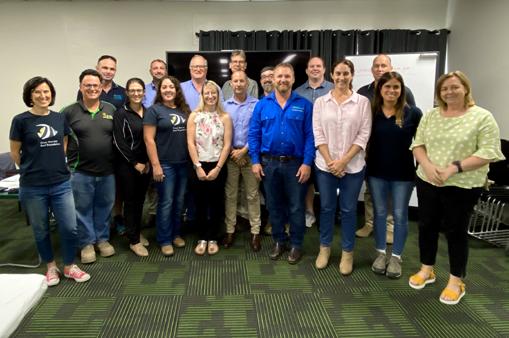
addressing water quality but also productivity and profitability for growers. It was also an opportunity to hear from growers participating in the projects and how they are benefiting from the projects.
catching up with SRA Burdekin District Manager Terry Granshaw who gave an update on the productivity plan, shed meetings, Burdekin Irrigation Project and upcoming events.
The SRA Burdekin Station hosted the Burdekin Regional Variety Committee which was jointly presented by BPS and SRA where new varieties under development were reviewed.
The Burdekin is very fortunate to have SRA Variety Officer Catherine Kettle whose passion and enthusiasm for her craft places us in a good position for the future. The Committee approved several varieties for acceleration in the program and it was also pleasing to see BPS’s relative performance to
other districts, which was very good, in terms of getting seed cane and new varieties out into the commercial world of growers paddocks.
CBL Directors attended the SRA/QUT Regional Research Seminar in Townsville to learn about the latest in milling research and technology and to interact with staff from the processing side and took the opportunity to provide them with feedback on the issues with processing cane with mud/ dirt compared to the past when factories could more readily process mud affected cane. One of these issues that contractors noticed in the 2022 season was more stool in the bins than previous years with
grub damage being the possible culprit and this will need to be monitored as it will have processing ramifications.
Steve Pilla represented CBL at the Burdekin Basin Governance Seminar which was organised and hosted by James Cook University with the message from the day being that the Burdekin water resource needs to be appropriately managed by stakeholders via a whole-ofbasin perspective to ensure water is not over allocated to avoid another Murray-Darling type disaster occurring.
CBL had four representatives at the QCGO Policy Council in Brisbane where the STL QSL insourcing issue captured airtime
THE OFFICIAL MAGAZINE OF AUSTRALIA'S SUGARCANE INDUSTRY 34
The GBRF Lower Herbert Water Quality Program forum held in the Herbert River.
on day two. Senior Management from QSL are meeting with the CBL Board to discuss their position further in addition to providing a strategic and market update. STL management will also be visiting the Burdekin to brief the CBL Board on their decision.
CBL also participated in a QCGO organised Education Strategy Workshop which is looking at developing school curriculum for the sugarcane industry through primary and secondary schools to help promote the sugarcane industry as a career path choice for school children. It is essential
PROSERPINE
With a very late district ‘Crush-out Party’ held on 18 March, initial estimates of the crop remain close to 1.7 million tonnes. Ratoons harvested before Christmas show good potential with some downside risk from late harvested ratoons and the uncertainty of standover crops. With medium term (April to June) rainfall forecasts slightly below average, it is hoped growth is not severely impacted but rather that CCS sees significant improvement on last year’s 13.56.
CANEGROWERS continues to monitor mill preparations with regular updates from the mill. This included a meeting held between CANEGROWERS Proserpine and Wilmar leadership on 8 March to discuss the challenges of 2022 and, more importantly, the current and future repairs and maintenance plans for

that we help make school children and the education system aware of the sugarcane industry’s importance to regional communities, a valued export earner for the country and as a viable career path for school leavers to pursue employment into.
The State Valuation Service issued new valuations for sugarcane land on 17 March which revealed an average land value increase of 15% which will have cashflow implications for Council rates. CBL is meeting with the Burdekin Shire Council in April to explore the issue and potential solutions.
CBL instigated a CSA Review Meeting with Wilmar in early March which will be progressed further with a subsequent meeting in April. In terms of other Wilmar activities, CBL met with Wilmar C, S & T to run through grouping changes applications and siding access requests for the 2023 season. Several harvesting groups have dropped out after the 2022 season and the trend is on for bigger groups which then has rostering and siding access issues. Wilmar has also uploaded farm maps and preliminary estimates for the upcoming 2023 season and it is
important that growers carefully check their estimate to ensure the mill has accurate data to progress their operational planning which impacts on growers and contractors. Wilmar are aiming to have the Burdekin districts initial estimate out in early April which will then determine start dates for 2023. It still feels like we just finished the 2022 season and the 2023 season will be on us before we know it.
Proserpine Mill. The mill is currently on track with its maintenance schedule, but many challenges remain to ensure a good start to the season. There has been a shift in focus on staffing requirements with various solutions being actioned including alternate labour sourcing, improved staff management approaches and even bin monitoring technologies. Mill performance will be a key to the success of 2023 as good sugar pricing continues.
CANEGROWERS Proserpine has appointed Jessica Harrison (CANEGROWERS Insurance) as a part-time Smartcane BMP facilitator. Her role will ensure Proserpine growers have the necessary support required for both new and re-accreditations. Growers who are interested are encouraged to contact
CANEGROWERS Proserpine office for more information.
CANEGROWERS Proserpine held a Board meeting on 2 March. The social media Board and Staff Member Facebook series continued with the second article featuring Justin Blair. Justin represents the upcoming generation of technology proficient growers who face a very different future in farming.
The growing importance of young farmers to the Proserpine district has also seen the introduction of a new ‘Young Farmers’ award to this year’s Show Cane event. Follow the CANEGROWERS Proserpine Facebook page and newsletters to keep up to date with the latest happenings and information.
35 APRIL 2023 – VOLUME 45/NUMBER 4
L-R: Sebastian Foti, Jed Page, Paul Giordani, Mike McLeod, Paul Turnbull, Russell Brown, Justin Blair, Bill Blair, Lindsey Altmann, Tony Large, Glenn Clarke, Bessie Orr, John Casey
The 2023 crop is shaping up to be another large one, with the crop responding well to rain at the right time in many areas. Some parts of the district are reporting patchier rain.
Late cut cane from the overlong 2022 harvest has been impacted by January’s deluge. That waterlogging in the late cut cane hasn’t been altogether surprising, given that the crush ran into that January monsoonal pulse. Many are calling it a ‘tale of two crops’cane cut before mid-November is looking magnificent, while the quality of the extensive
BURDEKIN BUNDABERG
Representatives from all sectors of the industry and their business associates gathered to hear the announcement of the 2022 Season Bundaberg Sugar Industry Awards on Friday 24 March. Awards winners included WR and AJ Baldry, announced as District Champion, Dale Holliss was recognised for his Contribution to Productivity and Heather Best for her extensive Service to Industry.
standover and late-cut ratoons remains to be seen.
With crop looking to be in the vicinity of last year’s large figures, area committees are urging millers to make the best of the shortened maintenance season to see an improvement in mill performance on 2022. Mill performance will be critical in getting this large crop away, and no one wishes to see a repeat on the large standover volumes of 2022.
Plane Creek Area Committee held its Annual Information Meeting in Sarina on 23 March, featuring a presentation on Business Essentials by
CANEGROWERS industry specialist Burn Ashburner, and the area’s members were pleased to welcome CANEGROWERS Chairman Owen Menkens. Mackay Area Committee is holding five shed meetings across the large milling area, opting for the relaxed atmosphere of sheds and a social barbecue mixed in with some valuable info around the crushes ahead and behind us.
In the past month, the CANEGROWERS Mackay board hosted a Mackay biofutures roundtable, including representatives from Greater

Whitsunday Alliance, Queensland University of Technology, Queensland State Development, Trade and Investment Queensland, and two emerging plant-based manufacturers keen to locate in the Mackay region. The meeting was positive and reaffirmed that the stars are aligning between opportunity and commercial/ government will for a value add in diversification to sugar cane uses. Any growers requiring assistance with any issues are encouraged to call 4944 2600 to get the ball rolling on a solution. Keep an eye on our Facebook page and weekly CEO Updates for emerging training and industry opportunities.
For a full list of award winners visit the Bundaberg CANEGROWERS website.
The crop estimate looks good and there has been some good rainfall across the district although due to the overcast days and short growth cycle, growth for the 2023 Season has been held back. Current indications are an estimate of 1.05 – 1.1m tonnes.
Glenn Harris from QSL is available to assist with the
transition to QSL Direct. If you have not completed your GPA, please contact Glenn on 0409 601 349 to do so. Glenn will be available to meet with you in Bundaberg at a mutually suitable time.
The Board recently met with STL to discuss future terminal arrangements and will meet with QSL in late April. We will continue to represent our members best interests on the issue and work toward
achieving the best outcome for our members.
We have been assisting Bundaberg Regional Ratepayers Association to support the launch of a petition sponsored by Stephen Bennett, Member for Burnett calling for the Guideline on Equity and Fairness in Rating for Queensland local governments to be made mandatory. The petition can be found at: https://bit.ly/3LRJNeG
THE OFFICIAL MAGAZINE OF AUSTRALIA'S SUGARCANE INDUSTRY 36
MACKAY / PLANE CREEK
MARYBOROUGH
Growers have been quick to sign up to the new Isis Mill CSA with almost all remaining growers now completed. The sugar price has maintained its high levels and growers have been able to secure excellent prices for this year and keeping a keen eye on 2024. The extended summer heat in the last few weeks had the irrigators busy but we are now receiving useful showers through the week to keep everything ticking along.
ISIS
The steamy growing conditions have continued across the district as well as the inconsistent follow-up rain. Sunwater have announced an out-ofallocation water event for Burnett River and the Isis and Woongarra channel customers. This means growers can take water from these systems at no cost. The out-of-allocation event has occurred as part of the Paradise Dam improvement project which will see the dam returned to its original height. As part of storage level management during the project water will be released to two downstream storages. When the volume released is greater than what can be stored the water is being made available to growers.
We are pleased to see the management of released water
Hearing of successful peanut harvesting currently under way without too many rain interruptions and the soybean crop continues to develop nicely through the district. Our District board recently recognised the many years of service from our past District Chair Jeff Atkinson with a dinner with board and partners. This had been delayed several times while trying to sort through mill supply arrangements.
Upcoming events for growers are:
• Information afternoon with QSL on 28 April from 3:30pm and drinks and food to follow.
• MCPS Bus Tour to Childers Wednesday 3 May with bus to leave from CANEGROWERS office Maryborough at 6:45am.
being undertaken in a carefully planned and methodical manner.
We have joined the Bundaberg Rate Payers Association in a bid to help increase the community voice in the run up to the March 2024 local Government elections. The committee is supporting a petition which has been lodged with the Queensland Government demanding Councils act fairly and equitably when applying rates.

Our board together with the Isis Mill Board and CANEGROWERS
Maryborough is preparing to meet with STL to discuss the operations of their terminal arrangements. Following the meeting our board agreed we will continue to work toward achieving the best outcome for our members.
Chairman Mark Mammino and Manager Jo Hall recently met with CANEGROWERS Maryborough
Chairman Roger Bambling and Manager Cameron Waterson to discuss working together now Maryborough growers have signed with Isis Mill.
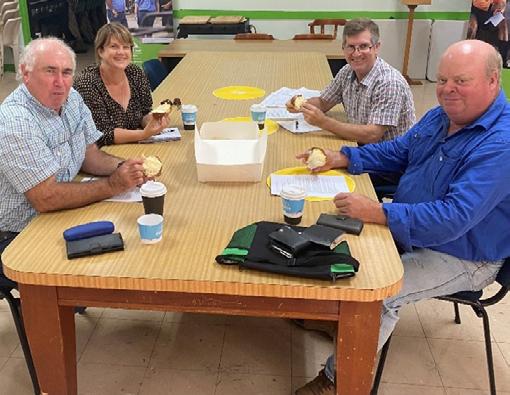
37 APRIL 2023 – VOLUME 45/NUMBER 4
Sharing some famous Childers cream buns Mark Mammino, Jo Hall CANEGROWERS Isis, Cameron Waterson, Roger Bambling CANEGROWERS Maryborough.
Dinner top celebrate Jeff Atkinson’s many years of service to CANEGROWERS Maryborough.
ROCKY POINT
After the dismal 2022 season in Rocky Point, and an estimated crop of 310,000 tonnes for 2023, we hope the Rocky Point Mill can complete the necessary maintenance by the end of June to successfully crush all our cane this season. We must capitalise on the strong sugar prices while available.
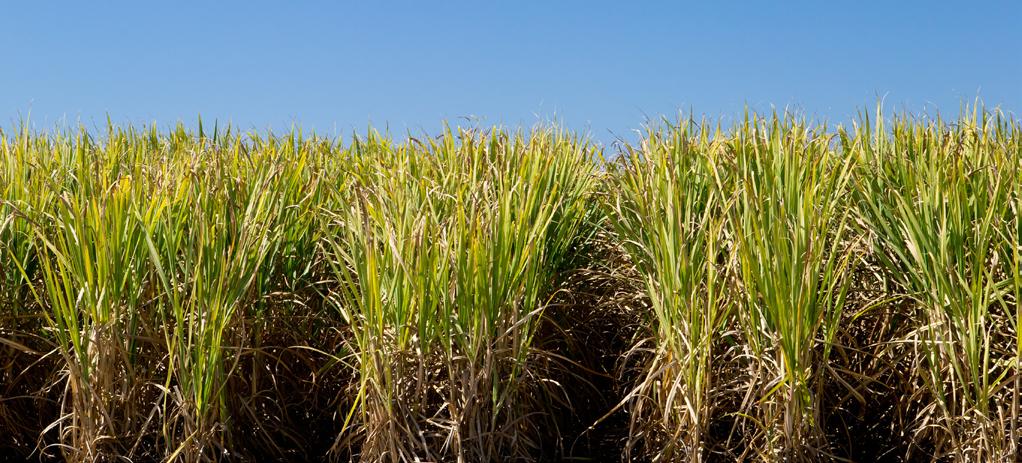
CSA negotiations with the Rocky Point Mill for the 2023-2027 years are progressing very slowly.

CANEGROWERS Rocky Point, in conjunction with SRA, held an Advanced Herbicide Workshop
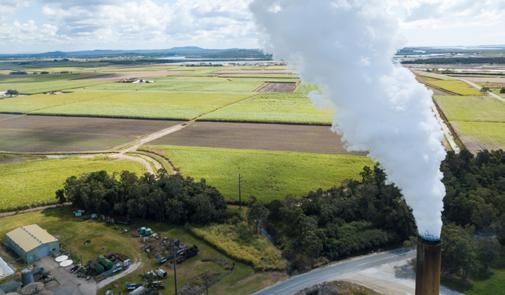
on 15 March, which was attended by almost 50 Rocky Point and NSW growers. It was a very informative day.
Approximately 200 ha of soybeans have been planted. Some growers got the beans in around Christmas, and those beans have done well due to reasonable rain over that time. However, over half the area was planted in mid to late February and there are some very poor strikes due to the dry hot conditions. This late planting was because of the late finish to the 2022 sugar cane season, on 5 February, with many growers leaving their plow out cane towards the season end.
Weather conditions are very dry at the moment, and we need rainfall to help the one year old and standover crops.
Growers are concerned about a rise in water levels throughout the drainage system, and Council is investigating the cause.
Council assures us that the rise in levels is not due to a new bridge being constructed across one of the main drainage floodgate points. The concern is if we have a rain event in the near future, there could be some major flooding across the district.
THE OFFICIAL MAGAZINE OF AUSTRALIA'S SUGARCANE INDUSTRY 38
Visit us at corteva.com.au Maximise your nitrogen investment. Minimise your environmental impact eNtrench® NXTGEN with Optinyte® technology works by keeping your nitrogen in the crop root zone for longer. To do this eNtrench NXTGEN inhibits the activity of the specific soil bacteria responsible for converting nitrogen into forms that can be rapidly lost from your soil. ®,TMTrademark of Corteva Agriscience and its affiliated companies Always follow the label as directed. ©Copyright 2022 Corteva.
SHOWCASING SUGARCANE
It’s showtime! In sugarcane growing districts up and down the coast the annual agricultural shows are a star attraction for the community.
After a long and arduous season last year, growers are looking forward to putting their best cane forward at their local Show Cane Competition.
In the picturesque sugar town of Proserpine Sarah Addis, CANEGROWERS Proserpine Executive Officer is once again looking forward to the annual competition and is proud of the history and support from local members.
“A good number of our members enter every year and members are very proud when their names are listed multiple times on trophies. When Show Whitsunday was suspended in 2020, we took the opportunity to reflect on our schedule, which had remained largely unchanged for many years. We took into consideration comments from judges that some sections continually received many high-quality entries and with only a first place to award. We also wanted to acknowledge young farmers within the area, as it’s an important group within the local farming community,” Sarah said.
“After much consideration and discussion, this year we have included an exciting new section to our schedule, the CANEGROWERS Young Farmer’s Trophy. Entrants must be aged 40 years or younger to participate in the new section and be actively farming cane. This new category provides an opportunity to reward and recognise the effort of younger growers specifically.”
Sarah said the competition overall continues to create a sense of community and the chance to bring members together, with support for the industry always bringing a crowd to the presentation afternoon.
“The history and tradition of the competition is well respected,” Sarah said, “the community love viewing the exhibit.”
31-year-old CANEGROWERS Proserpine Director Justin Blair is a big advocate of supporting and promoting the next generation of growers.
Many young growers work in the family business as going it alone is expensive and often unattainable. In some cases these growers navigate differing expectations and priorities
from multigenerational family members and may find it challenging. Justin is proud of the vast support networks available within the district where young growers can learn from not only experienced growers, but also share their own knowledge and gain a greater knowledge of the industry.
“The Proserpine Young Farmers Group started in 2019 and I started my first term on the local CANEGROWERS Board around then, I’m currently on my second term,” Justin said.
“I think it’s a really good industry to be involved in, there’s a lot of support.
“Like CANEGROWERS, SRA, Sugar Services Proserpine and other companies all have information and workshops to help you grow more healthy cane and the CANEGROWERS Business
Essentials is a great help with running your business.
“I’ve spoken to other young farmers in other ag industries, and they are very impressed with the support we have in our industry.
“A lot of us have grown up with the Show Cane Competition, helping tie up sticks of cane in preparation for the competition. Last year a couple of young growers put in some pretty impressive sticks, so this new category highlights that young growers are doing a great job and allows them to get rewarded and recognised.
“It’s great having the cane competition at the Whitsunday Show its one of the first things you see as you go through the gates, it’s a very visual and physical representation of the industry.”
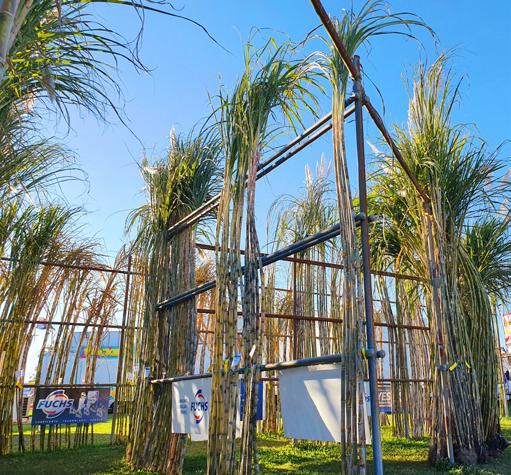
39 APRIL 2023 – VOLUME 45/NUMBER 4
SUSTAINABLE SWEETNESS: HOW SMARTCANE BMP IS SUPPORTING SUGAR FOR THE UK MARKET
Membership Engagement & Innovation
MATT KEALLEY

The Australian UK-Australia Free Trade Agreement (UKFTA) has opened up exciting new opportunities for Queensland sugarcane growers to expand their sugar exports to the UK market.
To ensure long-term success, addressing market access requirements and sustainability needs is crucial.
Thankfully, CANEGROWERS has taken a proactive approach to sustainability and is addressing concerns in the UKFTA through the Smartcane BMP program. This program provides practical guidance and tools to implement best management practices for cane, covering areas such as soil health, water management, pest and disease management, and nutrient management.
By participating in the program, growers can improve the sustainability of their farms, increase productivity and manage their costs. This not only benefits growers but also provides a competitive advantage in the UK market, where sustainable products are in high demand.
The UKFTA is a trade deal aimed at reducing tariffs and other trade barriers between Australia and the United Kingdom. The agreement benefits sugar by providing greater market access for Australian sugar
producers, enabling them to compete more effectively in the UK market and potentially increase their exports. Sustainability criteria are a significant part of the UKFTA, including environmental and social considerations.
These criteria involve reducing greenhouse gas emissions, protecting biodiversity and natural resources, promoting sustainable land use practices, ensuring fair and safe working conditions for workers, and respecting human rights.
For sugar from Queensland to access the UKFTA, it must meet these sustainability criteria and demonstrate a commitment to sustainable production and trade practices.
Furthermore, there is a growing trend in the UK market for products that address social needs, such as fair labour practices, environmental protection, and ethical sourcing.
Australian legislation supports social needs for sustainable sourcing through various mechanisms, including the Modern Slavery Act, which requires companies to identify and address modern slavery risks in their operations and supply chains.
Australia's Workplace Health and Safety (WH&S) and Fair Work Act also play a significant role in supporting social needs by ensuring workers are provided with a safe and healthy work environment, while the Fair Work Act safeguards their rights to fair wages and working conditions. By adhering to these laws, the Australian sugar industry operates responsibly and sustainably, ensuring sugar is ethically sourced and meets the UK's standards for sustainable sourcing.
The Queensland sugarcane industry is addressing market access needs through sustainable sourcing. Sugarcane sourced from growers who follow sustainable practices assures customers and regulators that their product is sustainably produced and traceable. By ensuring the supply chain is transparent and accountable, growers can build trust and reputation in the market, creating a competitive advantage that benefits both growers and the broader Queensland economy.
THE OFFICIAL MAGAZINE OF AUSTRALIA'S SUGARCANE INDUSTRY 40
CANEGROWERS is also exploring the use of blockchain technology to improve transparency and traceability in the sugarcane supply chain.
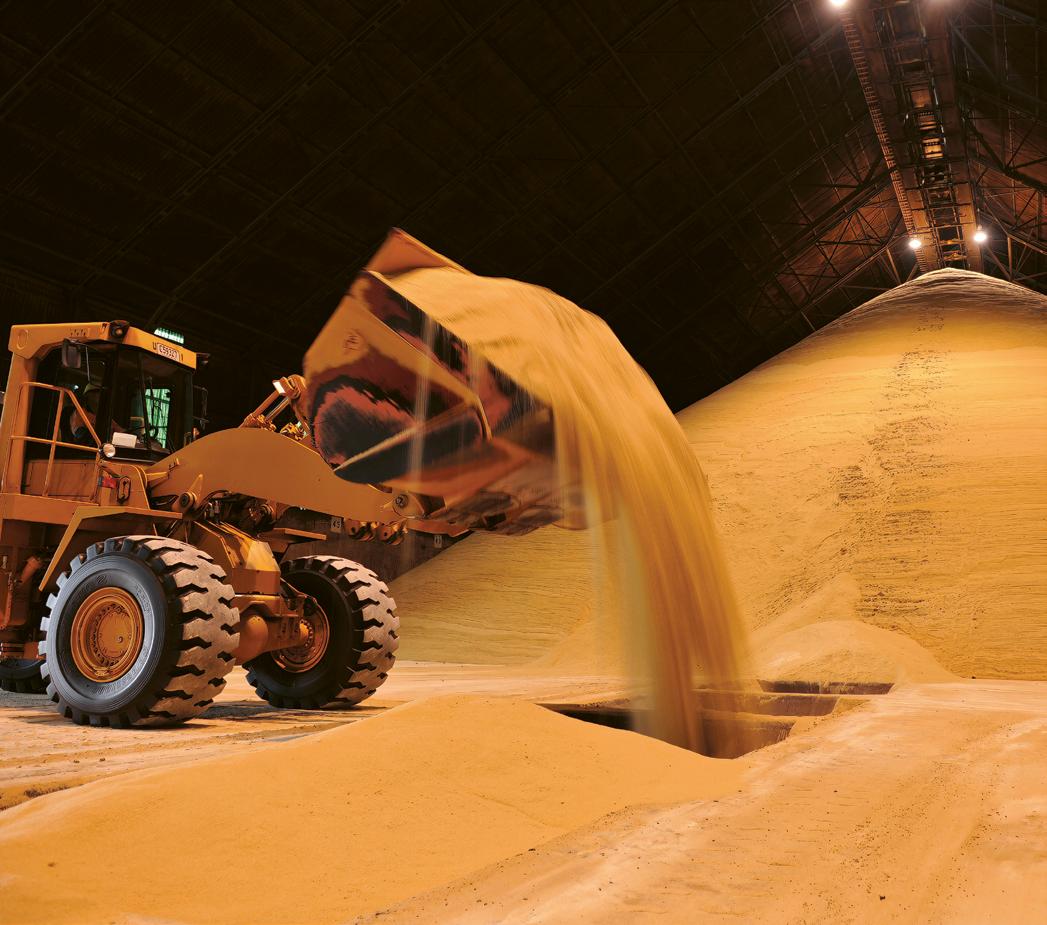
By using blockchain, the industry aims to provide customers with real-time information about the origin and quality of the sugarcane, which could help to support market access and increase consumer confidence.
By focusing on sustainability through Smartcane BMP, CANEGROWERS is successfully addressing sustainability
barriers to support access to the UK market. By working together with the Australian government and industry partners, and prioritising sustainability and social responsibility, a more competitive and sustainable product can be created that meets the UK market's demand for sustainable products, benefits growers, and contributes to the wider Queensland economy.
41 APRIL 2023 – VOLUME 45/NUMBER 4
NO EXCUSE FOR DELAYING MUCHNEEDED REFORMS TO REEF WATER QUALITY POLICIES AND PROGRAMS
Sustainability & Environment
MICK QUIRK

Our industry remains committed to pursuing further reductions in the impacts of farming on catchment water quality, where such measures are practical, evidence-based and economically viable for growers.
But there is widespread frustration, disappointment and resentment amongst growers about the Reef Water Quality Report Cards, and the persistent expectations of practice change that are not profitable or affordable. There are obvious flaws in the current arrangements that operate under the 2050 Water Quality Improvement Plan owned by the Australian and Queensland Governments, but significant reform is slow to occur.
For example, one long-standing flaw relates to the expectation that growers adopt the unfounded block yield approach to nitrogen use, requiring growers to reduce N rates up to 30% below optimum. In reality, this practice would reduce farm profits and compromise mill viability.
The CANEGROWERS Reef water quality policy summarises the reform actions required to address this and other flaws in current arrangements, including:
• Government targets for additional voluntary adoption of practices must be agreed with industry and be tailored to the needs and opportunities of each district or basin
• Practices that are the focus of targets for additional adoption must align with the Smartcane BMP program
• Targets for additional adoption of practices must be based on credible assessments of their economic merit, ease of demonstration, and other influential factors
• Develop a fit-for-purpose reporting framework that tracks practice adoption from projects and their impacts on water quality, with adequate levels of repeatability, sensitivity and reliability
• Abandonment of the deeply flawed Report Card system for Reef water quality
• A reality check on the extent to which practical and cost-effective changes to farm practice can contribute to the basin-specific targets for reductions in dissolved inorganic nitrogen (DIN)
• Development of basin reduction targets for DIN that are not “all or nothing”, and which reflect much better understanding of the relationship between DIN loads and the level of environmental risk Growers expect that stakeholders will take these concerns seriously and also take responsibility for making the necessary reforms. CANEGROWERS has consistently offered to work with government, and other stakeholders, to make these changes happen. But willingness to admit flaws, let along address these, has been lacking.
An actual opportunity for reform emerged last year when the Queensland Government announced a review of targets for adoption of farm practices that influence water quality. However, the report from this review fell well short of credible, evidence-based outcomes and was not supported.
We hope the Australian and Queensland Governments will recommence this review process with a more deliberate and patient approach. We don’t expect perfect outcomes, but they need to be credible and realistic, and tailored to each district or basin. They also need to be developed with industry and other stakeholders.
We also hope that major decisions about the future design and priorities of Reef Trust programs will wait for completion of this review – it’s findings will provide a roadmap for Reef Trust funding in each basin. How can effective funding decisions be made without such guidance?
THE OFFICIAL MAGAZINE OF AUSTRALIA'S SUGARCANE INDUSTRY 42
LEGALLY ACCESSING PUBLIC ROADS WITH OVERSIZED AGRICULTURAL VEHICLES.
Industry & farm Inputs
BURN ASHBURNER
Although the National Class 1 Agricultural Vehicle and Combination Mass and Dimension Exemption Notice has been in existence for many years there is still some confusion as to exactly what it is all about.
Any agricultural vehicle over 4.5t and over the “general access limits” (2.5m width, 12,5m single vehicle length, 19m combination length, 4.3m height and 3.7m rear overhang) is an over dimensional heavy vehicle. This means that they can only access public roads if they:
• Travel under the National Class 1 Agricultural Vehicle and Combination Mass and Dimension Exemption Notice and meet all the conditions in that or
• Have an exemption permit through The National Heavy Vehicle Regulator (NHVR) and meet the conditions of the permit.

Thus to access public roads legally with an agricultural vehicle a grower needs to:
1. Determine if its dimensions are within the “general access conditions” as above
2. If not then determine if the dimensions are within the allowed dimensions under the National Class 1 Agricultural Vehicle and Combination Mass and Dimension Exemption Notice
3. If not application should be made for an exemption permit through the National Heavy Vehicle Regulator’s permit portal.
A Notice is like what used to be called a “class permit”. The National Class 1
Agricultural Vehicle and Combination Mass and Dimension Exemption Notice covers the majority of all oversize agricultural vehicles in the sugarcane industry. This in general stipulates the vehicle types, dimensions and mass allowed over the general access limits (as above), the roads (or zones) that can be travelled on and the relevant conditions of travel (on vehicle signage, pilots etc.).
If all these conditions are met then any over dimensional heavy agricultural vehicle can legally access public roads. There is no application process or cost to the individual grower. However growers do need to know that they are traveling under this Notice and ensure conditions are complied with.
The Notice comes with supporting documents in the form of an Operators Guide, Zone maps and information sheets. These documents and the Notice can be found on the NHVR website at www.nhvr.gov.au/C2020G00213
An individual permit is required if you cannot meet the requirements of the Notice. Permits are generally for a specific vehicle or combination on specific roads with conditions unique to that permit. Currently permits should be issued for up to a year (CANEGROWERS is pushing for 3 years) for multiple trips and growers pay for each permit. Permit application information can be found at www.nhvr.gov.au/road-access/access-management/applications/ agricultural-vehicle-permit
In order for NHVR to issue the Notice or permit in Queensland they effectively require approval from the road managers (e.g. TMR and local Councils) and the Queensland Police. So, it is a collaborative effort.
This can be confusing and complex. CANEGROWERS has provided a summary by mill area which gives growers a pathway to understand the vehicle dimensions, the roads that can be travelled on and the basic conditions required (i.e. pilots) in the Notice. This can be found in the members only section of the CANEGROWERS website. Also look out for an information day near you with Transport and Main Roads and NHVR sometime in May. Travel safely and legally.
43 APRIL 2023 – VOLUME 45/NUMBER 4
ANNUAL QUEENSLAND LAND VALUATIONS – 2023
CANEGROWERS Legal Advisor

CURRENT REVALUATIONS
During March 2023 the Valuer General will issue new land valuations for 24 Local Government Authorities in Queensland, some of which are in sugarcane districts including Burdekin, Hinchinbrook, Mackay and Tablelands. If your property is in a local authority area that was not revalued, then your land valuation will remain unchanged.

WHAT ARE LAND VALUATIONS USED FOR?
Land valuations are used and relied upon by various government authorities for a variety of purposes including the levying of various taxes and charges against land holders. These taxes and charges are calculated at a specified rate in the dollar of land value. Examples include local council rates, state land tax and state land rental on state leasehold lands. An increase in your land valuation may, but does not automatically, lead to an increase in your relevant government rates and charges.
WILL MY COUNCIL RATES INCREASE?
Just because your Valuer General land valuation increases does not automatically mean your local council rates will also increase. Councils have very wide powers to manage rating and changes in property values.
Councils can apply caps, averaging of values over several years, differential rating and most obviously, changing the rate in the dollar of land value.
From my experience, I have noticed many local councils
use as an excuse the increase in land values by the State Valuer General to justify increases in local rates.
There however is no valid basis for this approach and councils certainly have many ways in which it can ensure that an increase in land values does not equate to an increase in rates.
HOW IS THE VALUATION CALCULATED?
Lands that are zoned rural are valued on an unimproved basis by State Government department valuers. The unimproved basis is intended to reflect the land in its original, natural and undisturbed condition.
The unimproved value is the notional amount the land could be expected to sell for without any physical improvements such as houses and sheds, land clearing, levelling and earth works. Department valuers usually monitor the local area real estate market and analyse sales of properties within the area.
From these sales, they will make calculations about the value of improvements forming part of the sale and deduct them from the gross sale price to come up with a notional
THE OFFICIAL MAGAZINE OF AUSTRALIA'S SUGARCANE INDUSTRY 44
CHRIS COOPER
unimproved value for the land component involved in that sale. Valuers will also consider physical attributes and constraints on use of the land.
These items include matters such as the shape, nature and size of land, any adverse effects of natural disasters, limitations on land use, encumbrances such as easements including cane tramway and powerline easements, planning restrictions and environmental and vegetation issues. The department does not physically inspect every property in the local authority area every year. Quite often the department will simply carry out desk top valuations using maps and aerial images. Also, in some cases the department will merely apply a factor to adjust the value of all farms by a set percentage. These short cut approaches can lead to anomalies and inconsistent valuations.
OBJECTION PROCESS
A land holder can formally dispute a valuation by lodgement of a notice of objection. The notice must follow a set format and be lodged with the department within 60 days of the valuation issuing. In certain special circumstances the Valuer General may accept a late objection.
REVIEW PROCESS
If a properly made objection has been lodged by a landholder, then the objection must be considered by senior valuer within the government department who was not involved in the original valuation. With the agreement of the objector and the valuer a conference to discuss the valuation may also be held. In some circumstances if there are a significant number of cane grower objectors, CANEGROWERS may also make submissions to the department. The department will reconsider the valuation and notify the objector of the decision.
APPEAL PROCESS
If the objector does not agree with the decision on the objection, then an appeal can be lodged with the Land Court within 60 days.
FURTHER ADVICE AND ASSISTANCE
The Department of Resources website (www. resources.qld.gov.au) contains useful information about the valuation process undertaken by it. Your local CANEGROWERS district office can also assist with advice and information.


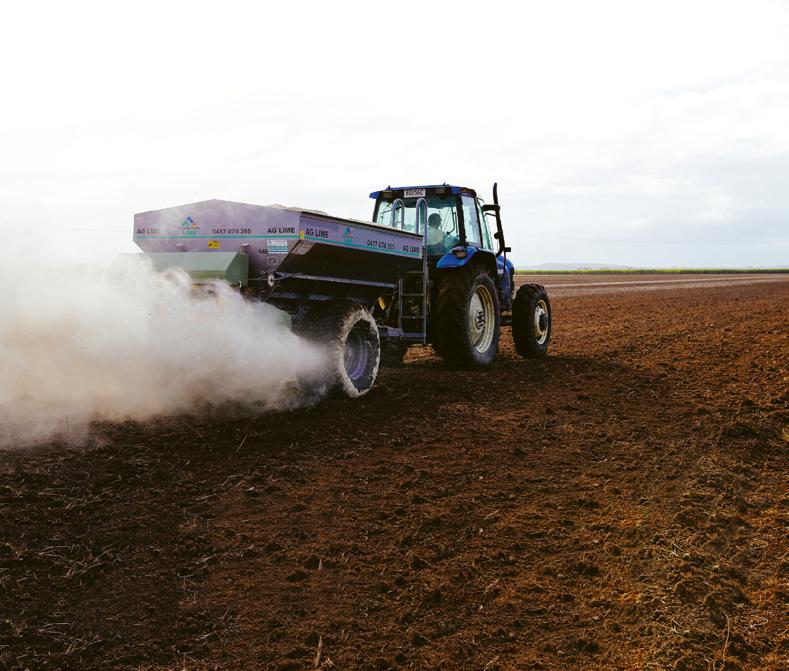
This article contains general advice only. The particular facts and circumstances of each case always need to be taken into account.

Any grower wishing to discuss aspects of this article or any other legal matter should contact your local CANEGROWERS office or call CANEGROWERS Legal Adviser, Chris Cooper, for free initial legal advice.
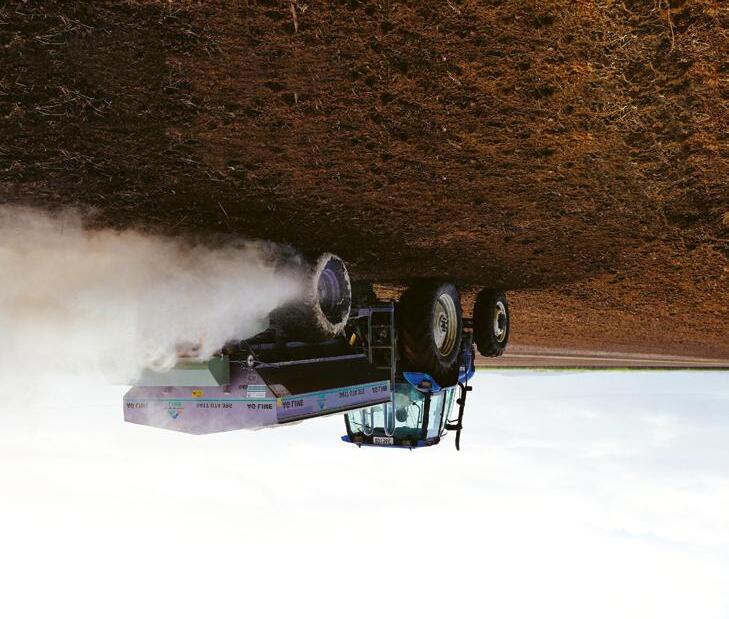
45 APRIL 2023 – VOLUME 45/NUMBER 4
"A land holder can formally dispute a valuation by lodgement of a notice of objection."
FIRST 5 LINES FREE* FOR CANEGROWERS MEMBERS! Book online 24/7 at www.canegrowers.com au or email us at ads@canegrowers.com.au Next deadline is 22nd April 2023
MOSSMAN-TULLY
2022 Case 9900 Harvester. Ph: Craig 0436 332 044
2018 Case 8810 Harvester. Ph: Craig 0436 332 044
2 of 2021 Case Puma 225 Cut with 16T GTB
Razor Tippers All Articulated units. Ph: Craig 0436 332 044
International 866 Tractor $11,000, 1000 Litre plus Diesel Tank on Stand $1800, 2 Ripper Coulter’s each $1900, Single Fertiliser Box Stool Splitter $700, Implement Rollers Each $200, 3 Row Scratcher $700, Line Marker $500, Ph 0412 968 434, 186 Ross Road DEERAL.
2 of 2019 Case Puma 210 cut with 14T GTB
Razor Tippers Ph: Craig 0436 332 044
2006 Case 7700 Track Harvester. 10.3Lt
Iveco Motor 3,500hrs. Very Good Condition
Ph: 0467 198 700 AH: 4067 1498
Multi-Weeder $350; Cane Drill Marker $250; Silvan 600L Water Tank $300. Ph: 07 4065 2165
Howard 80 inch Ripper Rotary (new blades & new ripper tips) $3,300. GST incl. 2 x second hand Tractor tyres. 20.8 38 8 ply $100 ea. GST incl. Ph. 0438 988 858
John Deere 7330 Premium, 150 HP, IVT Transmission, Power Beyond Row, Crop Tyres, 8,100 hours, comes with rear hubs and
USED MACHINERY FOR SALE
SECONDHAND 2021 8810 AUSTOFT
HARVESTER - MANY EXTRAS
EATON PUMPS TO SUIT 7700 & 8800 SERIES
All machines located in Ingham.
WE ARE HIRING:
COUNTER SALES POSITION AVAILABLE
Contact us via phone or email for further information.
SNG Machinery Sales
90 Origlasso St, Ingham
07 4776 6003 (Parts)
07 4776 1066 (Sales)
admin@sngmachinerysales.com
www.sngromano.net.au
*As a FREE service to CANEGROWERS members, Australian Canegrower will print suitable classified advertisements UP TO 5 LINES FREE, FOR ONE ISSUE ONLY. A charge of $5. 50 will apply for each extra line or part thereof. A charge will apply for advertising of non-cane growing activities. Advertisements must relate exclusively to cane farming activities, such as farm machinery, etc. Advertisements from non-members are charged at $11 per line incl GST. Only prepaid ads will be accepted.
spacers. In excellent condition. $70,000 (plus GST) Ph: Clinton 0439 965 921
John Deere 7520 Premium Cab, IVT Transmission, Power Beyond, Row Crop Tyres, 9,000 hours, In excellent condition $60,000 (plus GST) Ph: Clinton 0439 965 921
Toft 6000, CAT 3306DI, Rotary Chop, Bent elevator, standard topper. Good condition for age. Ph: 07 4067 5327
Silkwood Implements whole Stick plant cutter with topper $5,000 Includes GST Ph: Ron 0407 667 819
Quantity of used Harvester track platescurved and flat Ph: Ron 0407 667 819
2015 Case 280 Magnum Ultimate 1750 hrsequipped with Case Trimble FMX 1000 GPS $300,000 includes GST Ph: Ron 0407 667 819
2012 Case iH Magnum 340. 4950hrs, HydraulicTop Link 4 Remotes, Trimble RTK GPS Included. G/C $230,000 + GST. Ph: 0408 700 555 or 044 722 6739.
Planting set up, Ready to go. HBM single row billet planter, 1982 Toft 6000 with rubber rollers, rotary chop, Mercedes engine, 1989 Austoft powerhaul with 10t elevating bin. $55k ono plus GST. Liquaforce 5-row fertiliser applicator, 5000L rate controlled on 2006 NH TM140, 25000L stainless steel tanker trailer connected to 2006 NH TM140, all together $150K ono. 100" rotary hoe, 7 tyne Bonel ripper, heavy rollers, Hodge reversible 4 furrow plough, ratooning discs, 5tonne HBM tipper, ripper/rotary hoe, and more.
Ph: Rodney 0429984920 2011 John Deere 7200R FWA tractor, 5,915hrs, G/C, Trimble GPS, rear PTO, 3PL, front weights, tinted cab, $120,000 + GST.
Ph: Peter 0427 976 416
2012 Case 8800 fulltrack cane harvester fitted with Trimble GPS and new walking gear. All in good condition. 20t EHS tri-axel cane hauling bin fitted to 7810 John Deere. Ready for work. Near new 6t side tipper. Mulgrave Area
Ph: 0407 160 673
Billet Planter Harvester - Austoft 7000 optimised for billet planting $50,000+ GST.
Ph: 0439 852 185 or 0448 918 422.
Ford 5000 MF 178 with loader 411 Fiat High Clearance. Best Offer. Ph: 0473 332 751.
Kubota M9540 4850 Hrs G/C $38,000 + GST. Two Ford 5000 articulated tractors coupled to 4 t
side tippers $10,000 each + GST. One Ford 5000 tractor $8,000 + GST. Ph Jamie 0427 089 009
2010 Austoft A8800 Cane Harvester, New Motor, 1800 hrs, Walking Gear has done 1 Season, $90,000 inc. GST ono. Ph: 0407 630 499 or 0428 453 640
Ford 8340 SLE 4WD $30,000, Newton 6T Side Tipper $5,000, JD 4055 with Newton 6T Side Tipper, $20,000, 2 x Complete Axle Assemblies to suit HBM Tipper $600 for both. All + GST. Ph: 0429 652 235
2012 Case 8800 fulltrack cane harvester fitted with Trimble GPS and new walking gear. All in good condition. 20t EHS tri-axel cane hauling bin fitted to 7810 John Deere. Ready for work.Near new 6t side tipper. Mulgrave Area Ph: 0407 160 673
HERBERT RIVER – BURDEKIN
15KW WEG Mining motor High Efficiency E3 415 Volt 3 Phase 1470RPM. $1300 Neg inc GST. This motor was manufactured in Feb 2018 and was in service for 3 years until the switchboard was completely upgraded to fit a VSD for better pump control. Motor was in perfect working condition when taken out of service and has been sitting in the shed since then. Motor is complete with a taperlock and a 4 belt drive pulley. Current replacement cost is $2,150.00 bare motor ex Melb. without pulley. Ph: Mario 0429 181 276
MF178 Tractor. Reasonable running condition - Multipower, no canopy, new mud guards $10,000. Chain driven Row. Fertiliser box 1.5 tonne. trailled $1,000. 3pl Back blade no hydraulics. $600. Chamberlain Canelander Tractor good for spare tractor or tow boat $4,000 Ask for photos. Ph: John 0417070844
M135 4WD, 15,000hrs. Good Condition. $35,000 inc GST. Ph: 0407 636 055
2015 Austoft 8800 Harvester. Good Condition. Ph: 0499 888 919 or 0429 989 502.
Dunlite 7kva Generator. Honda GX390 petrol engine. Good condition. $1250.00
Ph: 07 4777 3181 after 7:00pm
International 1086 Trike (146HP). Tractor was manufactured as a trike from the factory and has the genuine front pedestal and twin front wheel set up. Complete with full set of front weights, standard 3 point linkage as well as a locally produced mid mount implement
THE OFFICIAL MAGAZINE OF AUSTRALIA'S SUGARCANE INDUSTRY 46
CLASSIFIEDS
46
toolbar. Tractor is in good operating condition other than the aircon which does not operate. Selling due to lack of use and taking up shed space. $12,000 + GST. Ph: 0429 181 276 for more information or photos.
1988 Ford 7700 - 6,720 hrs, 2WD, Single Remotes, Good Condition. $12,000 plus GST. Ph: 0407154250
MACKAY-PROSERPINE
Hodge billet planter for sale with double chains and single axle bin, stainless steel fertiliser box all in good condition. $22,000 plus GST. Ph: 0417 714 209 or 0428 165 142.
1 international 414 for sale, tyres 90% tread, engine needs repairs, $1,000. Ph: 4954 1174
Newton 10 tonne elevator bin for sale. Ph: 4954 1174 for price.
2016 Case 8800 Track Harvester; 4887 Hrs; Good Condition. PH: 0408755453 Proserpine
Goldacres 800Ltr spray unit with incab controls, 110 LPM pump, near new condition. No boom. Spare new solenoids included. Good condition. $3,200 + GST ono.
Ph: 0419 646 235.
Southern Cross centrifugal pump and 6 cylinder ford engine on a double axle trailer
$5500 Ph: 0437 184 822
Water meter never used SIEMENS BRAND (no before or after the meter pipework required) 150 MM FLANGED,TABLE D/E
Ph: 0411 196 860
6Tonne west tool cane trailer.
Ph: 0408 192 495 for price
Diesel Tank on 2 wheel trailer 4500 Litres
Ph: 0411 196 860
6 and 8 inch cast iron flanged Gate Valves. New never used. Ph: 0411 196 860
Howard AH 120” Rotary Hoe. New blades, oil cooler, hydraulic lift crumble roller. Always kept in shed. In great condition. $12600+GST.
Ph: 0428 761 324
Massey Ferguson 8110 4-wheel drive with cab, 135hp, only 2,636 hours in good condition.
$55,000 incl GST. Ph: 0438 606 578
1973 Ford 5000 2wd with 4ton Newton side tipper $11000 +GST .3m niemeyer nr1411
Power Harrows $5600 + GST. Ph: 0437 184 822
12t self-propelled 6x6 elev infielder. VGC. Mackay. Ph: 0438 606 578.
6t side tipper on Leyland tandem. GC. Mackay. Ph: 0438 606 578.
Don Mizzi 741 model on Fiat 750 special turbo plus MF102 half-tracks to suit. Mackay.
Ph: 0438 606 578.
Celli Tiger spike hoe, 2.5m wide with hydraulic crumble roller and oil cooler. VGC. Mackay. Ph: 0438 606 578.
Rainfall Report
6t side tipper Ian Ritchie, Excellent condition $15,000 + GST. Ph: 0478 719 294.
2 fan stripper $500. Moller single chain planter $4000. Roberts 6T goose neck trailer $5000. Grubber & box $300. Hodge upright planter $3000. Ph: 0408 776 336 OR 4959 1765 after 7pm Brought
47 APRIL 2023 – VOLUME 45/NUMBER 4 Zero
rainfall figures
subject to verification and may be updated later. Weather forecasts, radar and satellite images and other information for the farming community can be accessed on www.bom.gov.au. Weather report
from the Bureau of Meteorology Recent Rainfall Tables.
indicates either no rain or no report was sent. These
are
sourced
47
to you by LOCATION RECORDED RAINFALL (mm) Month prior (Feb 2023) Month to date (1 Mar - 26 Mar) Year to date 2023 Year to date 2022 Whyanbeel Valley (Mossman) 1239 375 2358.6 1093.8 Mareeba Airport 200.2 113.6 718.2 461.2 Cairns Aero 444.6 416.4 1254.6 854.8 Mt Sophia 666 618 1849 1772 Babinda Post Office 960.1 no data 1618 1677.4 Innisfail 756.6 381.2 1677.6 no data Tully Sugar Mill 716.5 412.1 1686.2 944.1 Cardwell Marine Pde 355.6 178.8 972.6 659 Lucinda Township 443 153.4 1103.4 638.4 Ingham Composite 454.6 195.4 1150 637.4 Abergowrie Alert 215 123 645 309 Townsville Aero 306.8 76.6 794 498 Ayr DPI Research Stn 116.6 84.2 785.2 289.2 Proserpine Airport 142.9 126.4 1221.9 680 Mirani Mary Street 137.8 282 1120.4 261.3 Mackay MO 121 46.8 845.6 370.2 Plane Creek Sugar Mill 47.9 86.4 889.1 419 Bundaberg Aero 123.4 75.4 283.8 562.8 Childers South 93.6 89 236.6 589.2 Maryborough 37.4 103.4 242.2 598.8 Tewantin RSL Park 47.8 82.4 178.6 1165.8 Eumundi - Crescent Rd 39.2 no data 76.6 1214.8 Nambour DPI - Hillside 94.2 51.2 238.2 1319.2 Logan City Water Treatment Plant 40.4 42.7 155.7 755.1 Murwillumbah Bray Park 258.7 44.1 349.8 303.3 Ballina Airport 245.6 115.4 433.6 1677.6 New Italy (Woodburn) 102.6 60.6 303.6 1645.6
BUNDABERG-ROCKY POINT
Daily row rake and centre row ripper. $150 plus gst. One tonne bag lifter. $150 plus gst. Ph. 0457447561
Massey Ferguson harvester 305 $5,000, stick plant cane cutter 3 point linkage $600, 2 fan stripper $500, whole stick planter $500, spinner weeder $600. All + GST. Ph: 0402 781 765
Howard rotary hoe 90 inch reasonable condition $3,000. Bonnel single stick cane planter good condition $1,000. Aged billet planter weathered condition $2,500. Belt spreader 3 ton bin good condition $15,000 Phone 0437266711.
2006 John Deere, Cameco 3510 track cane harvester suitable for 1.8m rows, in good condition. Ph: 0413 584 728
Bonel whole stick plant cane cutter 3 point linkage $500 plus GST. Dual row fertiliser machine with 4 counters ground wheel drive $500 plus GST. Ph: 0457 447 561.
Plant cane cultivator 2 x 1.6m row w/ 3 weeder rakes and tines $2,200 incl GST, Land plane w/ 4m. hyd. tilt blade $4,400 incl GST, 2x1.6m. row cultivator w/ 10x 30ml. tines $2,200 incl GST.Ph: 0408 761 463.
JD 2010 3520 harvester 7700hrs GC $175, 000 + GST. Ph: 0418 881 343.
Case 8810, 2018 model cut 4 seasons, low hour low tonnage machine, owner driver. Ph: 0427 271 278.
HBM billet planter set up for dual row or single. $9,000 + GST. Ph: 0413 584 728. 2 row Bonnel fertiliser box with ground drive, 1¼ inch tynes, $1,100 + GST. Ph: 0413 584 728
WANTED
6 Cylinder Turbo Cat Motor. Ph: 0417 193 385
A vintage 3 ton cane railway bin to display at the Childers historical complex QLD. Anything considered even parts. Email: Darrensbrengun@outlook.com Ph: 0402122790
1996 - 2004. Toft / Case 7000, wheeled cane harvester. Ph: 0420600943
Tractor with FEL 100-140 HP up to $50k. NQLD Area. Call Peter 0427760449
Cane stripper in good condition. Ph: 0407 675 361
Double 5 or 6 tonne side tipper with load sharing hitch. With or without tractor. Ph: 0418 379 253.
Weeder rake. Preferably heavy-duty frame, looking to modify. Condong area. Ph: 0438 428 113.
14 tonne elevator bin and tractor 50klm box or more. Preferably JCB. Ph: 0400 794 857.
Flat bed trailer approx. 3000 x 2100. Mackay/ Sarina area. Ph: 0439 752 381.
Service truck/trailer set up for harvester. Must have a good compressor. Ph: 0437 503 818.
PROPERTY - FOR SALE
Cane Farm for sale: 117 acres, fully irrigated, extremely good bore, Kinchant Dam water and creek water, frontage Peak Downs Highway, Eton and no house. Ph: 4954 1174 for price.
15km South of Cairns. Looking for a large parcel of land (approx 115 Acres) only 3Km from Edmonton. Currently growing Sugar Cane this farm would also be suitable to run cattle or horses or grow fruit trees or alternate crops. With over 1.5km of Wrights creek frontage this gives you access to your own fishing and crabbing spot. Ph: Steve 0410 600 247
Cane land at Gollogly’ Road, Hawkins Creek. 2 Separate parcels. 1st parcel: 57 acres. 2nd Parcel: 47 acres. Sell as one parcel. Priced to sell. Contact 0747761750 after 7pm. Mobile 0409411149. Genuine buyers only. Ingham area.
Sugar Cane Farm - Mulgrave Valley - 218 Acres for sale. Situated less than 4kms from Gordonvale Township is this existing sugar cane farm with 2km of river frontage. Farming area is approx 185 acres of fertile land with average yield in excess of 5000 tonnes. With good rainfall in the area there is no need to irrigate. Ph: Steve 0410 600 247
Established Sugar Cane Farm in the Highleigh area of Gordonvale 25 Km South of Cairns City. Regarded as one of the premiere farms in the district averaging over 100 tonne/ hectare. The farm is well managed with 20 acres fallow, 20 acres plant cane and regular rotation of ratoon crops. Situated only 4km from the township of Gordonvale for shopping, schools, medical and general farm supplies. Ph: Steve 0410 600 247
Cane farm for sale, 31.94ha, 2 combined lockable sheds, boundary on Russell River, Bartle Frere. Ph: 0418774849
Cane farm for sale, 124.95ha, 2 x large sheds, highway frontage, machinery & house, Silkwood area. Ph: 0467 333 989.
Cane Farm Cooks Lane Victoria Plantation. 69.75 ha. 61.38 ha under cane. High producing area. 1km from Victoria Mill. Road frontage. Ph: 0427 912 277.
Cane farm, 89 hectares, 220 acres at Como Road on Trebonne Creek, 5 minutes from the Ingham CBD. Contact Felix Reitano Real Estate on 4776 5007 or felix@reitano.com.au
70ha Cane Farm with 61.5 ha under cane. Located 8 km from town centre and 1 km from Victoria Mill. Property is flood free with town
water supply running along property front. Paddocks have all been lasered and are well maintained and up to date with new varieties.
Ph: 0427 912 277.
Cane farm to lease Munburra, Sunnyside or Oakenden areas. Have own equipment.
Ph: 0408 011 983.
840 meters opposite Moore Park Beach. Coastal Cane Farm 93 Acres and 146 megalitres of ground water. Large storage Shed. 1 x Diesel Irrigation pump for the underground irrigation. There are 2 fenced off areas, currently used for horses and cattle. No house on this property. Comes with crop.
Ph: Larry: 0418 496 864
PROPERTY - WANTED
Wanted permanent purchase Lower Mary River Water Allocations on Mary River, Tinana Creek and Channel Pipeline sections of the scheme. Ph: 0427 930 696
Want to buy farm in Victoria Plains, Eton, Pleystowe area. Ph 049 00 29 387.
Wanting to buy/lease cane farm in the Septimus area. Ph: 0417 607 722.
Wanting to buy/lease cane farm. Close to Racecourse mill, Tekowai, Alexandra areas. Ph: 0438 545 251.
Want to buy farm in the Mackay or Proserpine area. Must have two good condition houses and irrigation. Ph Paul: 0447 545 550.
WTB: Grazing & Irrigation Property. Grazing to run 300-500 head. 100 - 200 acres irrigation. Located Sarina-Proserpine Regions. Ph James: 0429 621 145
THE OFFICIAL MAGAZINE OF AUSTRALIA'S SUGARCANE INDUSTRY 48CLASSIFIEDS 48
WANT THE LATEST NEWS AND PHOTOS? Find CANEGROWERS on: www.facebook.com/CANEGROWERSAustralia
2 N D & 3 R D M A Y
B U N D A B E R G R E G I O N
Tickets available 1st March 2023 through Ticketebo
Day 1 |
Bargara Cultural Centre 160 Hughes Rd, Bargara


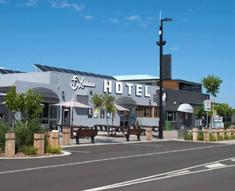
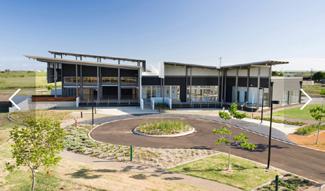
Conference
8 30am - 3 00pm

Guest Speakers & Local Atrisian Markets




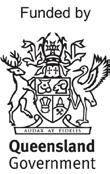
Followed by Guest Speaker Angela Williams
Formal Dinner
2nd May Day 2 | Wednesday 3rd May 6.00pm
Presenting ‘Walking the Wire’ & Live Entertainment

ticketebo.com.au/wisa2023 Conference 2023 W O R T H Women of


Bus Trip & Lunch 8 30am to 3pm
Bundaberg Brewed Drinks One Little Farm
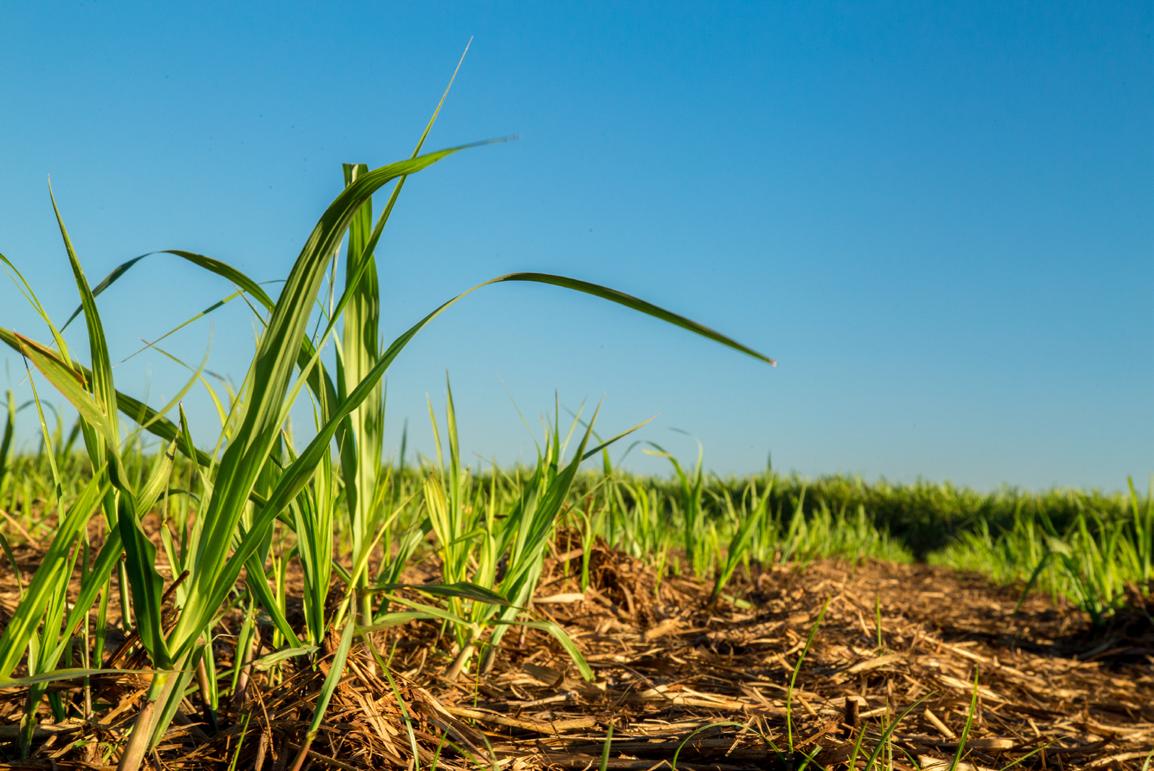
Bundaberg Rum
The Lighthouse Hotel

The Lighthouse Hotel 66 Zunker St, Burnett Heads Tuesday
to 11.30pm
SProudlyupported by
in
Follow the link to purchase or for more information
Dept Justice & Attorney General Investing
QLD Women Grant
WISA


AT HOME HILL SHOWGROUNDS AT HOME HILL SHOWGROUNDS FRI 27 MAY SAT 28 MAY 5:30PM - 11PM 11AM - 4PM sweetdayshotnights.com.au for festival updates, information and how to get involved, please visit: @sweetdayshotnights @visitburdekin A night that brings together our diverse community with an amazing line-up of cultural performances, fun activities for the kids and authentic street food from around the world. A highlight of the evening will be the lighting of the first cane fire for the 2023 sugarcane crushing season! Experience a test of skill and endurance from a bygone era as hand cane cutters compete for the winning title. Bring the whole family to enjoy live music, free children’s rides and activities and a variety of food vans. ADULTS 18+ TICKETS $5 • UNDER 18s FREE! FREE ENTRY! VISITBURDEKIN.com.au Get the most out of your Burdekin Stay, go to... AYR HOME HILL BOWEN PROSERPINE Burdekin TOWNSVILLE CAIRNS MACKAY INNISFAIL INGHAM CHARTERS TOWERS Burdekin featuring


































































 Reversing straight to a programmed positional line. Photo: Clayton Grech
Reversing straight to a programmed positional line. Photo: Clayton Grech





















































